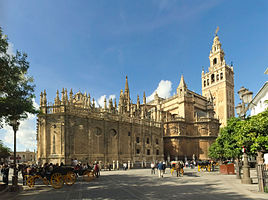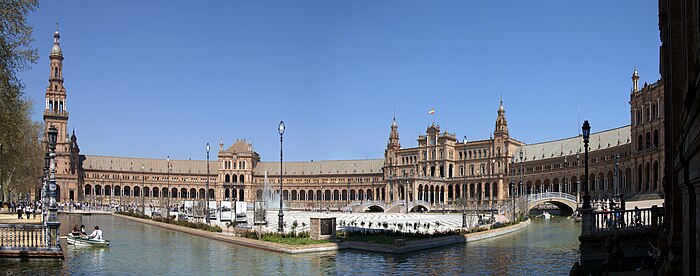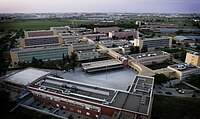Seville
Seville
Sevilla(Spanish) | |
|---|---|
| Motto: NO8DO([Ella] No me ha dejado – [She] has not abandoned me) | |
 Location of Seville | |
| Coordinates:37°23′24″N5°59′24″W/ 37.39000°N 5.99000°W | |
| Country | |
| Autonomous Community | |
| Province | Seville |
| Government | |
| • Type | Ayuntamiento |
| • Body | Ayuntamiento de Sevilla |
| • Mayor | José Luis Sanz(PP) |
| Area | |
| •Municipality | 140 km2(50 sq mi) |
| Elevation | 7 m (23 ft) |
| Population (2021) | |
| •Municipality | 684,234 |
| • Rank | 4th |
| • Density | 4,900/km2(13,000/sq mi) |
| •Urban | 1,100,000[1] |
| •Metro | 1,519,639 |
| Demonym(s) | Sevillan, Sevillian sevillano(m.),sevillana(f.) hispalense |
| GDP | |
| • Metro | €36.785 billion (2020) |
| Time zone | UTC+1(CET) |
| • Summer (DST) | UTC+2(CEST) |
| Postcode | 41001–41020, 41070–41071, 41080, 41092 |
| Website | www |
Seville(/səˈvɪl/sə-VIL;Spanish:Sevilla,pronounced[seˈβiʎa]) is the capital and largest city of theSpanishautonomous communityofAndalusiaand theprovince of Seville.It is situated on the lower reaches of theRiver Guadalquivir,in the southwest of theIberian Peninsula.
Seville has a municipal population of about 701,000 as of 2022[update],and ametropolitanpopulation of about 1.5 million, making it the largest city in Andalusia, thefourth-largest city in Spainand the25th most populous municipalityin theEuropean Union.Itsold town,with an area of 4 square kilometres (2 sq mi), contains aUNESCOWorld Heritage Sitecomprising three buildings: theAlcázar palace complex,theCathedraland theGeneral Archive of the Indies.The Seville harbour, located about 80 kilometres (50 miles) from the Atlantic Ocean, is the only river port in Spain.[3]The capital of Andalusia features hot temperatures in the summer, with daily maximums routinely above 35 °C (95 °F) in July and August.
Seville was founded as theRomancity ofHispalis.Known asIshbiliyahafter theIslamic conquestin 711, Seville became the centre of the independentTaifa of Sevillefollowing the collapse of theCaliphate of Córdobain the early 11th century; later it was ruled byAlmoravidsandAlmohadsuntil being incorporated to theCrown of Castilein 1248.[4]Owing to its role as gateway of theSpanish Empire's trans-atlantic trade, managed from theCasa de Contratación,Seville became one of the largest cities in Western Europe in the 16th century. Coinciding with theBaroque period,the 17th century in Seville represented the most brilliant flowering of the city's culture. Following a deterioration in drought conditions in the Guadalquivir, the American trade gradually moved away from the city of Seville, in favour initially of downstream-dependent berths and eventually of theBay of Cádiz– to which were eventually transferred control of both thefleets of the Indies(1680) and theCasa de Contratación(1717).[5]
The 20th century in Seville saw the tribulations of theSpanish Civil War,decisive cultural milestones such as theIbero-American Exposition of 1929andExpo '92,and the city's election as the capital of theAutonomous Community of Andalusia.
Name
[edit]Etymology and derivatives
[edit]According to Manuel Pellicer Catalán, the ancient name wasSpal,and it meant "lowland" in thePhoenician language(cognateto the HebrewShfelaand the ArabicAsfalأسفل).[6][7]It is ultimately from Phoeniciansefela,meaning "plain, valley."[8]Hisbaalis another old name for Seville. It appears to have originated during thePhoeniciancolonisation of theTartessianculture in south-western Iberia, and according to a new proposal, it refers to the godBaal.[9]
DuringRoman rule,the name was Latinised asHispaland later asHispalis.After theUmayyadinvasion, this name remained in use among theMozarabs,[10]being adapted into Arabic asIšbīliya(إشبيلية): since the /p/phonemedoes not exist in Arabic, it was replaced by /b/; the Latin place-name suffix-iswas Arabized as-iya,anda/æ/turned intoī/iː/due to the phonetic phenomenon calledimāla.[11]
In the meantime, the city's official name had been changed toḤimṣ al-Andalus(حمص الأندلس), in reference to the city ofHomsin modern Syria,the jund of whichSeville had been assigned to upon the Umayyad conquest;[12][13][10][14]"Ḥimṣ al-Andalus" remained a customary and affectionate name for the city during the whole period throughout the Muslim Arab world,[10][15][16]being referred to for example in the encyclopedia ofYaqut al-Hamawi[17]or inAbu al-Baqa ar-Rundi'sRitha' al-Andalus.[18]
The city is sometimes referred to as the "Pearl of Andalusia".
The inhabitants of the city are known assevillanos(feminine form:sevillanas) orhispalenses,after the Roman name of the city.
Motto
[edit]NO8DOis the official motto of Seville, popularly believed to be arebussignifying the SpanishNo me ha dejado,meaning "She [Seville] has not abandoned me". The phrase, pronounced withsynalephaas[nomaðeˈxaðo]no-madeja-do, is written with an eight in the middle representing the wordmadeja[maˈðexa]"skein [of wool]". Legend states that the title was given by KingAlfonso X,who was resident in the city'sAlcázarand supported by the citizens when his son, laterSancho IV of Castile,tried to usurp the throne from him.
The emblem is present on Seville's municipal flag, and features on city property such as manhole covers, andChristopher Columbus's tomb in the cathedral.
History
[edit]Seville is approximately 2,200 years old. The passage of the various civilizations instrumental in its growth has left the city with a distinct personality, and a large and well-preserved historical centre.
Early periods
[edit]

The mythological founder of the city is Hercules (Heracles), commonly identified with the Phoenician godMelqart,who the myth says sailed through theStrait of Gibraltarto the Atlantic, and founded trading posts at the current sites ofCádizand of Seville.[19]The original core of the city, in the neighbourhood of the present-day street, Cuesta del Rosario, dates to the 8th century BC,[20]when Seville was on an island in theGuadalquivir.[21]Archaeological excavations in 1999 found anthropic remains under the north wall of the Real Alcázar dating to the 8th–7th century BC.[22]The town was calledHisbaalby the Phoenicians and by the Tartessians, the indigenous pre-Roman Iberian people ofTartessos,who controlled the Guadalquivir Valley at the time.
The city was known fromRoman timesasHispaland later asHispalis.Hispalis developed into one of the great market and industrial centres of Hispania, while the nearby Roman city ofItalica(present-daySantiponce,birthplace of the Roman emperorsTrajanandHadrian)[23]remained a typically Roman residential city. Large-scale Roman archaeological remains can be seen there and at the nearby town ofCarmonaas well.
Existing Roman features in Seville itself include the remains exposedin situin the underground Antiquarium of theMetropol Parasolbuilding, the remnants of anaqueduct,three pillars of atempleinMármolesStreet, the columns ofLa Alameda de Hérculesand the remains in the Patio de Banderas square near theSeville Cathedral.The walls surrounding the city were originally built during the rule ofJulius Caesar,but their current course and design were the result of Moorish reconstructions.[24]
Following Roman rule, there were successive conquests of the Roman province ofHispania Baeticaby the GermanicVandals,SuebiandVisigothsduring the 5th and 6th centuries.
Middle Ages
[edit]In the wake of theIslamic conquest of the Iberian Peninsula,Seville (Spalis) was seemingly taken byMusa ibn Nusayrin the late summer of 712, while he was on his way toMérida.[25]Yet it had to be retaken in July 713 by troops led by his sonAbd al-Aziz ibn Musa,as the Visigothic population who had fled toBejahad returned to Seville once Musa left for Mérida.[25]The seat of theWaliofAl-Andalus(administrative division of theUmayyad Caliphate) was thus established in the city until 716,[25]when the capital of Al-Andalus was relocated toCórdoba.[26]
Seville (Ishbīliya)was sacked by Vikingsin the mid-9th century. After Vikings arrived by 25 September 844, Seville fell to invaders on 1 October, and they stood for 40 days before they fled from the city.[27]During Umayyad rule, under an Andalusi-Arab framework, the bulk of the population wereMuladiconverts, to which Christian and Jewish minorities added up.[28]Up until the arrival of theAlmohadsin the 12th century, the city remained as the see of a Metropolitan Archbishop,[29]the leading Christian religious figure in al-Andalus. However, the transfer of the relics ofSaint IsidoretoLeóncirca 1063, in the taifa period, already hinted at a possible worsening of the situation of the local Christian minority.[30]
Apowerfultaifakingdom with capital in Sevilleemerged after 1023,[31]in the wake of thefitna of al-Andalus.Ruled by theAbbadid dynasty,the taifa grew by aggregation of smaller neighbouringtaifas.[31]During the taifa period, Seville became an important scholarly and literary centre.[31]After several months of siege, Seville was conquered by theAlmoravidsin 1091.[32]
The city fell to the Almohads on 17 January 1147 (12Shaʽban541).[33][34]After an informal Almohad settlement in Seville during the early stages of the Almohad presence in the Iberian Peninsula and then a brief relocation of the capital of al-Andalus to Córdoba in 1162 (which had dire consequences for Seville, reportedly depopulated and under starvation),[35]Seville became the definitive seat of the Andalusi part of the Almohad Empire in 1163,[36][37]a twin capital alongsideMarrakesh.Almohads carried out a large urban renewal.[38]By the end of the 12th century, the walled enclosure perhaps contained 80,000 inhabitants.[39]

In the wider context of the Castilian–Leonese conquest of the Guadalquivir Valley that ensued in the 13th century,Ferdinand IIIlaid siege on Seville in 1247. Anaval blockadecame to prevent relief of the city.[40]The city surrendered on 23 November 1248,[41]after fifteen months of siege. The conditions of capitulation contemplated the eviction of the population, with contemporary sources seemingly confirming that a mass movement of people out of Seville indeed took place.[42]
The city's development continued after theCastilianconquest in 1248. Public buildings were constructed including churches—many of which were built in theMudéjarandGothicstyles—such as the Seville Cathedral, built during the 15th century withGothic architecture.[43]Other Moorish buildings were converted into Catholic edifices, as was customary of the Catholic Church during theReconquista.The Moors' Palace became the Castilian royal residence, and duringPedro I's rule it was replaced by the Alcázar (the upper levels are still used by theSpanish royal familyas the official Seville residence).
In the1391 pogromagainst the Jews, believed to having been instigated by the ArchdeaconFerrant Martínez,all the synagogues in Seville were converted to churches (renamed Santa María la Blanca, San Bartolomé, Santa Cruz, and Convento Madre de Dios). The Jewish quarter's land and shops (which were located in modern-daySanta Cruz neighbourhood) were appropriated by the church and many Jewish homes were burned down. 4000 Jews were killed during the pogrom and many others wereforced to convert.
The first tribunal of theSpanish Inquisitionwas instituted in Seville in 1478. Its primary charge was to ensure that all nominal Christians were really behaving like Christians, and not practicing what Judaism they could in secret. At first, the activity of the Inquisition was limited to the dioceses ofSevilleandCórdoba,where the Dominican friar, Alonso de Ojeda, had detectedconversoactivity.[44]The firstAuto de Fétook place in Seville on 6 February 1481, when six people were burned alive. Alonso de Ojeda himself gave the sermon. The Inquisition then grew rapidly. The Plaza de San Francisco was the site of the 'autos de fé'. By 1492, tribunals existed in eight Castilian cities: Ávila, Córdoba, Jaén, Medina del Campo, Segovia, Sigüenza, Toledo, and Valladolid;[45]and by theAlhambra Decreeall Jews wereforced to convertto Catholicism or be exiled (expelled) from Spain.[46]
Early modern period
[edit]Following theColumbian explorationof theNew World,Seville was chosen as headquarters of theCasa de Contrataciónin 1503, which was the decisive development for Seville becoming the port and gateway to the Indies.[47]Unlike other harbors, reaching the port of Seville required sailing about 80 kilometres (50 mi) up the River Guadalquivir. The choice of Seville was made in spite of the difficulties for navigation in the Guadalquivir stemming from the increasingtonnageof ships as a result of the relentless drive to make maritime transport cheaper during the late Middle Ages.[48]Nevertheless, technical suitability issues notwithstanding, the choice was still reasonable in the sense that Seville had become the largest demographic, economic and financial centre of Christian Andalusia in the late Middle Ages.[49]In addition, factors favouring the choice of Seville include the Andalusian coastline being largely under the seigneurial control of theHouse of Medina Sidonia,Seville enjoying an important hinterland and administrative expertise, and its inland location also providing conditions for military security and enforcement of tax control.[50]
A 'golden age of development' commenced in Seville, due to its being the only port awarded the royal monopoly for trade withSpanish Americasand the influx of riches from them. Since onlysailing shipsleaving from and returning to the inland port of Seville could engage in trade with the Spanish Americas, merchants from Europe and other trade centers needed to be in Seville to acquire New World trade goods. The city's population grew to more than a hundred thousand people.[51]
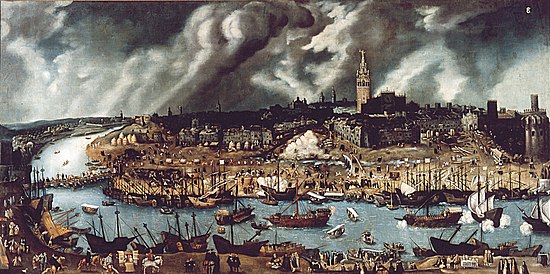

In the early 17th c., Seville's monopoly on overseas trade was broken, with the port ofCádiznow the monopoly port of trade assiltingof the Guadalquivir river in the 1620s made Seville's harbors harder to use.[52][53]TheGreat Plague of Sevillein 1649, exacerbated by excessive flooding of the Guadalquivir, reduced the population by almost half, and it did not recover until the early 19th century.[54][55]By the 18th century, Seville's international importance was in steep decline, after the monopoly port for the trade to the Americas was relocated to Cádiz. Cádiz had gifted the Bourbon claimant to the throne in theWar of the Spanish Successionfunding that helped it pursue the war. The reward to Cádiz was the rights of the monopoly port. TheHouse of Trade(which registered ships, cargoes, and persons travelling to the New World), and the large scale overseas commercial enterprises of themerchant guildrelocated to Cádiz. The House of Trade had been housed in rented quarters, but the purpose-built headquarters of the merchant guild was left vacant.[56]
During the monarchy ofCharles III,theArchive of the Indieswas established in Seville in the old headquarters of the merchant guild. Documents pertaining to Spain's overseas empire were moved there from existing archival repositories, includingSimancasand the House of Trade, were consolidated in a single repository. One scholar argues that the establishment of the Archive of the Indies marks a decisive moment in Spain's history, with the 18th c. Bourbon monarchy conceiving of its overseas territories as colonies of the metropole rather than entities under the jurisdiction of the crown on an equal basis as the kingdoms in the Iberian peninsula.[57]

During the 18th century Charles III promoted Seville's industries. Construction of theReal Fábrica de Tabacos(Royal Tobacco Factory)began in 1728. It was the second-largest building in Spain, after the royal residenceEl Escorial.[citation needed]Since the 1950s it has been the seat of the rectorate (administration) of theUniversity of Seville,as well as its Schools of Law, Philology (language/letters), Geography, and History.[58]
More operas have been set in Seville than in any other city of Europe. In 2012, a study of experts concluded the total number of operas set in Seville is 153. Among the composers who fell in love with the city areBeethoven(Fidelio),Mozart(The Marriage of FigaroandDon Giovanni),Rossini(The Barber of Seville),Donizetti(La favorite), andBizet(Carmen).[59]
The first newspaper in Spain outside of Madrid was Seville'sHebdomario útil de Seville,which began publication in 1758.
Late modern history
[edit]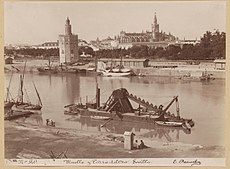
Between 1825 and 1833, Melchor Cano acted as chief architect in Seville; most of the urban planning policy and architectural modifications of the city were made by him and his collaborator Jose Manuel Arjona y Cuba.[60]
Industrial architecture surviving today from the first half of the 19th century includes the ceramics factory installed in the Carthusian monastery at La Cartuja in 1841 by the Pickman family, and now home to the El Centro Andaluz de Arte Contemporáneo (CAAC),[61]which manages the collections of the Museo de Arte Contemporáneo de Sevilla.[62]It also houses the rectory of the UNIA.[63]
In the years that QueenIsabel IIruled directly, about 1843–1868, the Sevillian bourgeoisie invested in a construction boom unmatched in the city's history. TheIsabel II bridge,better known as the Triana bridge, dates from this period; street lighting was expanded in the municipality and most of the streets were paved during this time as well.[64]
By the second half of the 19th century, Seville had begun an expansion supported by railway construction and the demolition of part of its ancient walls, allowing the urban space of the city to grow eastward and southward. TheSevillana de ElectricidadCompany was created in 1894 to provide electric power throughout the municipality,[65]and in 1901 thePlaza de Armasrailway station was inaugurated.

TheMuseum of Fine Arts(Museo de Bellas Artes de Sevilla)opened in 1904.
In 1929 the city hosted theIbero-American Exposition,which accelerated the southern expansion of the city and created new public spaces such as theParque de María Luisa(Maria Luisa Park) and the adjoiningPlaza de España.Not long before the opening, the Spanish government began a modernisation of the city in order to prepare for the expected crowds by erecting new hotels and widening the mediaeval streets to allow for the movement of automobiles.[66]

Seville fell very quickly at the beginning of theSpanish Civil Warin 1936. GeneralQueipo de Llanocarried out a coup within the city, quickly capturing the city centre.[67]Radio Seville opposed the uprising and called for the peasants to come to the city for arms, while workers' groups established barricades.[67]Queipo then moved to capture Radio Seville, which he used to broadcast propaganda on behalf of the Francoist forces.[67]After the initial takeover of the city, resistance continued among residents of the working-class neighbourhoods for some time, until a series of fierce reprisals took place.[68]
UnderFrancisco Franco's rule Spain was officially neutral in World War II (although it did collaborate with theAxis powers),[69][70][71]and like the rest of the country, Seville remained largely economically and culturally isolated from the outside world. In 1953 the shipyard of Seville was opened, eventually employing more than 2,000 workers in the 1970s. Before the existence of wetlands regulation in the Guadalquivir basin, Seville suffered regular heavy flooding; perhaps worst of all were the floods that occurred in November 1961 when the River Tamarguillo, a tributary of the Guadalquivir, overflowed as a result of a prodigious downpour of rain, and Seville was consequently declared a disaster zone.[72]
Trade unionism in Seville began during the 1960s with the underground organisational activities of the Workers' Commissions or Comisiones Obreras (CCOO), in factories such as Hytasa, the Astilleros shipyards, Hispano Aviación, etc. Several of the movement's leaders were imprisoned in November 1973.[citation needed]
Recent developments
[edit]On 3 April 1979 Spain held its first democratic municipal elections after the end of Franco's dictatorship; councillors representing four different political parties were elected in Seville. On 5 November 1982,Pope John Paul IIarrived in Seville to officiate at a Mass before more than half a million people at the fairgrounds. He visited the city again on 13 June 1993, for the International Eucharistic Congress.
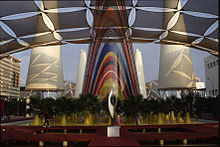
In 1992, coinciding with the fifth centenary of theDiscovery of the Americas,theUniversal Expositionwas held for six months in Seville, on the occasion of which the local communications network and urban infrastructure was greatly improved under a 1987PGOUplan launched by MayorManuel del Valle:[73]the SE-30 ring road around the city was completed and new highways were constructed; the newSeville-Santa Justa railway stationhad opened in 1991, while the Spanish High-Speed Rail system, theAlta Velocidad Española(AVE), began to operate between Madrid-Seville. TheSeville Airportwas expanded with a new terminal building designed by the architectRafael Moneo,and various other improvements were made. TheAlamillo Bridgeand theCentenario Bridge,both crossing over the Guadalquivir, also were built for the occasion. Some of the installations remaining at the site after the exposition were converted into the Scientific and Technological ParkCartuja 93.
In 2004 the Metropol Parasol project, commonly known asLas Setas('The Mushrooms'), due to the appearance of the structure, was launched to revitalise thePlaza de la Encarnación,for years used as a car park and seen as a dead spot between more popular tourist destinations in the city. The Metropol Parasol was completed in March 2011,[74]costing just over €102 million in total, more than twice as much as originally planned.[75]Constructed from crossed wooden beams,Las Setasis said to be the largest timber-framed structure in the world.[76]
Geography
[edit]Location
[edit]
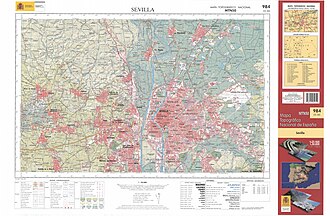
Seville has an area of 141 km2(54 sq mi), according to the National Topographic Map(Mapa Topográfico Nacional)series from theInstituto Geográfico Nacional – Centro Nacional de Información Geográfica,the country's civilian survey organisation (pages 984, 985 and 1002). The city is situated in the fertile valley of the River Guadalquivir. The average heightabove sea levelis 7 metres (23 feet). Most of the city is on the east side of the river, whileTriana,La CartujaandLos Remediosare on the west side. TheAljaraferegion lies further west, and is considered part of the metropolitan area. The city has boundaries on the north withLa Rinconada,La AlgabaandSantiponce;on the east withAlcalá de Guadaira;on the south withDos HermanasandGelvesand on the west withSan Juan de Aznalfarache,TomaresandCamas.
Seville is on the sameparallelas United States west coast citySan Josein central California.São Miguel,the main island of theAzoresarchipelago, lies on the same latitude. Further east from Seville in theMediterranean Basin,it is on the same latitude asCataniain Sicily, Italy and just south ofAthens,the capital ofGreece.Beyond that, it is located on the same parallel as South Korean capital,Seoul.Seville is located inland, not very far from the Andalusian coast, but still sees a much more continental climate than the nearest port cities,CádizandHuelva.Its distance from the sea makes summers in Sevilla much hotter than along the coastline.
Climate
[edit]
Seville's climate is a veryhot-summer Mediterranean climate(Köppen climate classificationCsa,Trewartha+Universal Thermal Scale:Cshl), featuring very hot, long, dry summers and mild winters with moderate rainfall.[77]Seville has an annual average of 19.2 °C (67 °F). The annual average temperature is 25.4 °C (78 °F) during the day and 13.0 °C (55 °F) at night.[78]Seville is located in theGuadalquivir Valley,which is often referred to as "the frying pan of Spain", as it features the hottest cities in the country.[79][80][81]
Seville is the warmest city inContinental Europe.[82]It is also the hottest major metropolitan area in Europe, with summer average high temperatures of above 35 °C (95 °F)[83]and the hottest in Spain.[84]After the city ofCórdoba(also in Andalusia), Seville has the hottest summer inEuropeamong all cities with a population over 100,000 people, with average daily highs of 36.0 °C (97 °F) in July.[85]On average, Seville has around 60 days a year with maximum temperatures over 35.0 °C (95.0 °F).[86]
Temperatures above 40 °C (104 °F) are not uncommon in summer. In fact, it became the first city in the world to name aheat wave,with a nickname "Zoe".[87]The hottest temperature extreme of 46.6 °C (116 °F) was registered by the weather station atSeville Airporton 23 July 1995 while the coldest temperature extreme of −5.5 °C (22 °F) was also registered by the airport weather station on 12 February 1956.[88]A historical record high (disputed) of 50.0 °C (122 °F) was recorded on 4 August 1881, according to theNOAASatellite and Information Service.[89]There is an unaccredited record by the National Institute of Meteorology of 47.2 °C (117 °F) on 1 August during the2003 heat wave,according to a weather station (83910 LEZL) located in the southern part of Seville Airport, near the former US San Pablo Air Force Base. This temperature would be one of the highest ever recorded in Spain, yet it hasn't been officially confirmed.[90]
The average sunshine hours in Seville are approximately 3000 per year. Snowfall is virtually unknown. Since the year 1500, only 10 snowfalls have been recorded/reported in Seville. During the 20th century, Seville registered just 2 snowfalls, the last one on 2 February 1954.[91][92]
- Winters are mild: December and January are the coolest months, with average maximum temperatures around 16 to 17 °C (61 to 63 °F) and minimums of 6 to 7 °C (43 to 45 °F).
- Summers are very hot: July and August are the hottest months, with average maximum temperatures around 35 to 36 °C (95 to 97 °F) and minimums of 20 to 21 °C (68 to 70 °F).
- Precipitationvaries from 500 to 600 mm (19.7 to 23.6 in) and there are around 50 rainy days per year, with frequenttorrential rain.December is the wettest month, with an average rainfall of 99 millimetres (3.9 in).
| Climate data forSeville Airport(1991-2020) (Provisional normals), extremes (1941–present) | |||||||||||||
|---|---|---|---|---|---|---|---|---|---|---|---|---|---|
| Month | Jan | Feb | Mar | Apr | May | Jun | Jul | Aug | Sep | Oct | Nov | Dec | Year |
| Record high °C (°F) | 24.2 (75.6) |
28.0 (82.4) |
32.9 (91.2) |
36.9 (98.4) |
41.0 (105.8) |
45.2 (113.4) |
46.6 (115.9) |
45.9 (114.6) |
44.8 (112.6) |
37.4 (99.3) |
31.2 (88.2) |
24.5 (76.1) |
46.6 (115.9) |
| Mean daily maximum °C (°F) | 16.3 (61.3) |
18.3 (64.9) |
21.6 (70.9) |
24.0 (75.2) |
28.2 (82.8) |
32.9 (91.2) |
36.2 (97.2) |
36.2 (97.2) |
31.6 (88.9) |
26.3 (79.3) |
20.3 (68.5) |
16.9 (62.4) |
25.7 (78.3) |
| Daily mean °C (°F) | 11.2 (52.2) |
12.7 (54.9) |
15.6 (60.1) |
17.8 (64.0) |
21.6 (70.9) |
25.7 (78.3) |
28.5 (83.3) |
28.6 (83.5) |
25.0 (77.0) |
20.6 (69.1) |
15.2 (59.4) |
12.2 (54.0) |
19.6 (67.2) |
| Mean daily minimum °C (°F) | 6.0 (42.8) |
7.0 (44.6) |
9.5 (49.1) |
11.6 (52.9) |
14.9 (58.8) |
18.5 (65.3) |
20.7 (69.3) |
20.9 (69.6) |
18.4 (65.1) |
14.9 (58.8) |
10.1 (50.2) |
7.4 (45.3) |
13.3 (56.0) |
| Record low °C (°F) | −4.4 (24.1) |
−5.5 (22.1) |
−2.0 (28.4) |
1.0 (33.8) |
3.8 (38.8) |
8.4 (47.1) |
11.4 (52.5) |
12.0 (53.6) |
8.6 (47.5) |
2.0 (35.6) |
−1.4 (29.5) |
−4.8 (23.4) |
−5.5 (22.1) |
| Averageprecipitationmm (inches) | 56.3 (2.22) |
46.2 (1.82) |
46.9 (1.85) |
51.5 (2.03) |
33.9 (1.33) |
5.8 (0.23) |
0.6 (0.02) |
2.5 (0.10) |
33.1 (1.30) |
75.4 (2.97) |
72.6 (2.86) |
77.2 (3.04) |
502 (19.77) |
| Average precipitation days(≥ 1 mm) | 5.9 | 5.3 | 5.5 | 6.0 | 4.2 | 1.0 | 0.1 | 0.4 | 2.8 | 6.3 | 6.1 | 6.5 | 50.1 |
| Averagerelative humidity(%) | 74.8 | 67.8 | 62.0 | 57.8 | 51.1 | 45.5 | 42.4 | 45.6 | 54.1 | 63.5 | 71.5 | 76.5 | 59.4 |
| Mean monthlysunshine hours | 202.0 | 212.2 | 246.3 | 270.2 | 324.9 | 357.3 | 388.1 | 364.3 | 278.4 | 244.4 | 205.3 | 185.9 | 3,279.3 |
| Source 1:Agencia Estatal de Meteorologia(AEMET OpenData) for temperatures and precipitation[93] | |||||||||||||
| Source 2:NOAAfor precipitation days, humidity and sunshine[94] | |||||||||||||
| Climate data forSeville Airport(1981–2010) | |||||||||||||
|---|---|---|---|---|---|---|---|---|---|---|---|---|---|
| Month | Jan | Feb | Mar | Apr | May | Jun | Jul | Aug | Sep | Oct | Nov | Dec | Year |
| Mean daily maximum °C (°F) | 16.2 (61.2) |
18.1 (64.6) |
21.9 (71.4) |
23.4 (74.1) |
27.2 (81.0) |
32.2 (90.0) |
36.0 (96.8) |
35.5 (95.9) |
31.7 (89.1) |
26.0 (78.8) |
20.2 (68.4) |
16.6 (61.9) |
25.4 (77.7) |
| Daily mean °C (°F) | 11.0 (51.8) |
12.5 (54.5) |
15.6 (60.1) |
17.3 (63.1) |
20.7 (69.3) |
25.1 (77.2) |
28.2 (82.8) |
27.9 (82.2) |
25.0 (77.0) |
20.2 (68.4) |
15.1 (59.2) |
11.9 (53.4) |
19.2 (66.6) |
| Mean daily minimum °C (°F) | 5.7 (42.3) |
7.0 (44.6) |
9.2 (48.6) |
11.1 (52.0) |
14.2 (57.6) |
18.0 (64.4) |
20.3 (68.5) |
20.4 (68.7) |
18.2 (64.8) |
14.4 (57.9) |
10.0 (50.0) |
7.3 (45.1) |
13.0 (55.4) |
| Averageprecipitationmm (inches) | 66 (2.6) |
50 (2.0) |
36 (1.4) |
54 (2.1) |
31 (1.2) |
10 (0.4) |
2 (0.1) |
5 (0.2) |
27 (1.1) |
68 (2.7) |
91 (3.6) |
99 (3.9) |
539 (21.2) |
| Average precipitation days(≥ 1 mm) | 6.1 | 5.8 | 4.3 | 6.1 | 3.7 | 1.3 | 0.2 | 0.5 | 2.4 | 6.1 | 6.4 | 7.5 | 50.5 |
| Averagerelative humidity(%) | 71 | 67 | 59 | 57 | 53 | 48 | 44 | 48 | 54 | 62 | 70 | 74 | 59 |
| Mean monthlysunshine hours | 183 | 189 | 220 | 238 | 293 | 317 | 354 | 328 | 244 | 217 | 181 | 154 | 2,918 |
| Source:Agencia Estatal de Meteorología[95][96] | |||||||||||||
Government
[edit]Municipal government and administration
[edit]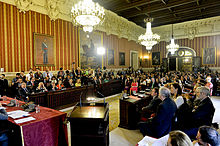
Seville is amunicipality,the basic level of local government in Spain. TheAyuntamientois the body charged with the municipal government and administration. The Plenary of theayuntamientois formed by 31 elected municipal councillors, who in turn invest themayor.Thelast municipal electiontook place on 28 May 2023. The current mayor isJosé Luis Sanz(People's Party), who has held the post since 17 June 2023.
Regional and provincial capital
[edit]Seville is the capital of the autonomous community ofAndalusia,according to Article 4 of theStatute of Autonomy of Andalusiaof 2007, and is the capital of theProvince of Sevilleas well. The historical building of thePalace of San Telmois now the seat of the presidency of theAndalusian Autonomous Government.The administrative headquarters are in Torre Triana, inLa Cartuja.TheHospital de las Cinco Llagas(literally, "Hospital of the Five Holy Wounds" ) is the current seat of theParliament of Andalusia.
Districts and neighbourhoods
[edit]The municipal administration is decentralized into 11 districts, further divided into 108 neighbourhoods.
- Casco Antiguo
- Distrito Sur
- Triana
- Macarena
- Nervión
- Los Remedios
- Este-Alcosa-Torreblanca
- Cerro-Amate
- Bellavista-La Palmera
- San Pablo-Santa Justa
Demographics
[edit]| Year | Pop. | ±% |
|---|---|---|
| 1842 | 100,498 | — |
| 1857 | 112,529 | +12.0% |
| 1860 | 118,298 | +5.1% |
| 1877 | 133,247 | +12.6% |
| 1887 | 143,840 | +7.9% |
| 1897 | 145,728 | +1.3% |
| 1900 | 147,271 | +1.1% |
| 1910 | 153,258 | +4.1% |
| 1920 | 205,723 | +34.2% |
| 1930 | 217,788 | +5.9% |
| 1940 | 302,300 | +38.8% |
| 1950 | 374,138 | +23.8% |
| 1960 | 441,869 | +18.1% |
| 1970 | 545,692 | +23.5% |
| 1981 | 645,817 | +18.3% |
| 1991 | 683,028 | +5.8% |
| 2001 | 684,633 | +0.2% |
| 2011 | 698,042 | +2.0% |
| 2021 | 684,340 | −2.0% |
| Source:National Statistics Institute[97] | ||
As of the 2021 census, the population is 684,340, down 2% from 2011 after a long period of continuous growth.
Main sights
[edit]Seville is a big tourist centre in Spain. In 2018, there were over 2.5 million travellers and tourists who stayed at a tourist accommodation, placing it third in Spain after Madrid and Barcelona. The city has an overall low level of seasonality, so there are tourists year-round.[98]There are many landmarks, museums, parks, gardens and other kinds of tourist spots around the city so there is something for everyone. The Alcázar, the cathedral, and theGeneral Archive of the Indiesare UNESCOWorld Heritage Sites.
Many of the city's most important sights and monuments are located in the historic centre (Casco Antiguo). To the north of the centre is the Macarena neighbourhood, which contains some important monuments and religious buildings, such as the Museum and Catholic Church ofLa Macarenaor theHospital de las Cinco Llagas.Across the river, on the west bank of the Guadalquivir, the neighbourhood of Triana had an important role in the history of the city.
Churches
[edit]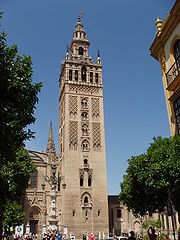
The Seville Cathedral, officially the Cathedral of Saint Mary of the See, is considered the largest Gothic cathedral in the world and one of the largest cathedrals in the world.[99][100][101]Incorporating parts of the city's former main mosque that was built under the Almohads in the 12th century, the current building is a massive Gothic structure begun after 1401 and finished in 1506, with additional reconstruction occurring between 1511 and 1519.[102]The church contains a number of important tombs, including one of the two claimed burial places of Christopher Columbus,[103]as well as many important artworks, including the largestretable(altarpiece) in Spain.[102]A number of later additions, mostly inPlateresqueorRenaissance style,were added around the outside of the Gothic structure after its initial construction.[102]
One of the city's most prominent landmarks is the cathedral's bell tower, theGiralda,formerly the minaret of the Almohad mosque. The minaret's main shaft is a little over 50 meters tall. The tower was further heightened in the 16th century by the addition of a large Renaissance-stylebelfry,which brings its total height to around 95 or 96 meters.[104][105]The top of the tower is crowned by theGiraldillo,a cast bronzeweather vanesculpture, from which the name "Giralda" is derived.[105]
TheChurch of San Salvador,located atPlaza de San Salvador,is the second largest church in the city after the cathedral. Originally converted from the city's oldest mosque, it was rebuilt inBaroqueform in the 17th century and was the city's onlycollegiate church.[106]TheChurch of Saint Louis of France,built between 1699 and 1731 and designed byLeonardo de Figueroa,represents another example of Baroque architecture.[106][107]
Palaces and mansions
[edit]
To the south of the cathedral, the Alcázar is a sprawling palace and garden complex which served as the city's center of power. The site was occupied since ancient times but was located outside the Roman city walls.[108]The current palace complex was founded in the 10th century as a governor's palace, then expanded in the 11th century when it became the palace of the Abbadid rulers. Some limited parts of the palace still date from its 12th-century expansion under Almohad rule, but most of the site was redeveloped after the Christian conquest of the city in the 13th century. A major construction campaign took place in the 1360s under Pedro I, who constructed a new palace in Mudéjar style, aided in part by craftsmen from Granada. Richly-decorated chambers and courtyards date from this period, such as thePatio de las Doncellasand theSalón de Embajadores.[108][109]Further additions took place under theCatholic Monarchsin Renaissance style, which continued under theHabsburgs.The extensive gardens were also redesigned in this style and then further developed in the 17th century.[102]The palace has been used as a filming location for various productions, includingGame of Thrones.[110]

TheArchbishop's Palacestands over the site of the formerRoman bathsof the city. The property was originally donated by Ferdinand III to Bishop Don Remondo in 1251, but the current building was built in the second half of the 16th century, followed by later additions. Its Baroque doorway was completed in 1704 by Lorenzo Fernándes de Iglesias.[111]
A number of other houses and wealthy mansions have been preserved across the city since the 16th century.[112]Among the most famous is theCasa de Pilatos('House of Pilate'), an aristocratic mansion blending multiple architectural styles. The house, bought by the Enriquez de Ribera family in 1483,[113]has a typical courtyard plan but mixes olderIsabellineand Mudéjar decoration with later Renaissance elements.[114]After Don Fadrique Enriquez de Ribera returned from a pilgrimage to Jerusalem in 1520, he commissioned a stoneportalat the entrance of the family mansion. The portal became the starting point for theVia Crucis to the Cruz del Campo,and later writers claimed it was modeled on the doorway of the house ofPontius Pilatein the Holy Land, thus earning the house its current name.[114][113]
Other historic mansions include thePalace of the Countess of Lebrija,thePalacio de las Dueñas,and theCasa de los Pinelos.TheCasa del Rey Morois considered the oldest in Seville, with its origins dated to the 15th century.[115]
Fortifications
[edit]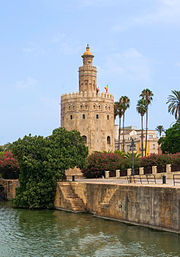
Thecity walls of Sevillewere first built in ancient times on the orders ofJulius Caesar.[116]After the Viking attack on the city in 844, the walls were rebuilt on the orders ofAbd ar-Rahman II.They were expanded under the Almoravids in 1126 and in 1221 the Almohads added a moat and a second outer line of walls. Most of the walls were demolished after 1861 to reduce restrictions on urban development, but a significant portion of the northern walls can still be seen today.[116]
TheTorre del Orois an Almohad defensive tower dating to 1220–1221. The tower was integrated into the city's defensive system and protected the city's harbour, along with another tower across the river. Between the bases of the two towers a chain could be raised to block ships and prevent entry into the port.[117]
Civic buildings and other monuments
[edit]
TheCity Hall(Ayuntamiento) was begun by architectDiego de Riaño,who worked on it between 1527 and 1534 and designed the eastern façade onPlaza de San Francisco,a highlight of the Plateresque style.[118][119]He was succeeded by other architects, includingHernan Ruiz IIafter 1560, who added a double-archedloggiaon the western façade.[119]The Royal Prison originally stood nearby, where Cervantes was imprisoned and where it is believed he was inspired to writeDon Quixote.[119]In 1840, the nearby Convent of San Francisco was demolished and replaced by the present-dayPlaza Nuevain 1854. After this, the city hall's was partly remodeled by Demetrio de los Ríos and Balbino Marrón. It was given a new western façade inNeoclassicalstyle, completed in 1867.[119][120]
The General Archive of the Indies (Archivo General de Indias), located between the Cathedral and the Alcázar, is the repository of valuable archival documents relating to the Spanish Empire in the Americas and the Philippines up to 1760.[121]The building itself was designed in aSpanish Renaissance stylein 1572 byJuan de Herrerato house the merchants' guild. Construction began in the 1580s and was not finished until 1646. The building was converted into the new Archive of the Indies in 1785.[122]

ThePalacio de San Telmowas originally a naval college established in 1671. Between 1722 and 1735 the building was completed by Leonardo de Figueroa and his son Matías, who designed its present-day façade, one of the most important monuments of Baroque architecture in Andalusia.[107]The building now serves as the seat for theAndalusian Autonomous Government.[123]
TheRoyal Tobacco Factory(Real Fábrica de Tabacos), located near the Palacio de San Telmo, was built between 1728 and 1771. It was designed in a Baroque style by Sebastian van der Borcht.[107]It replaced an earliertobaccofactory built in 1687, which in turn had replaced Seville's first tobacco factory, San Pedro, which opened in a former women's penitentiary in 1620.[124]Upon completion, the new factory was the largest industrial building in the world and included its own chapel and its own prison, and operated under its own laws.[124]
The city'sbullring,theReal Maestranza,was designed in 1761 by Vicente San Martin. Its Baroque façade was completed in 1787 but the rest of the building was only completed in 1881.[125]The venue can accommodate 14,000 spectators.[126]
The Metropol Parasol, inLa Encarnaciónsquare, is the world's largest wooden structure.[127]A monumental umbrella-like building designed by the German architectJürgen Mayer,finished in 2011. This modern architecture structure houses the central market and an underground archaeological complex. The terrace roof is a city viewpoint.[128]
Parque de María Luisa
[edit]
The sprawlingParque de María Luisa(María Luisa Park) was designed by architect Aníbal González for the 1929 Ibero-American Exposition. The park includes two major plazas, thePlaza de Españaand thePlaza de América,and several monuments and museums. They include outstanding examples of regionalistRevival architecture,a mix ofNeo-MudéjarandNeo-Renaissance,lavishly ornamented with typical glazed tiles.[129][130]
At the park's north end, the semi-circularPlaza de Españais marked by tall towers and a series of benches covered in painted tiles dedicated to each of the 48provinces of Spain.[129]The location has been used in the filming of several movies.[131]
At the southern end of the park, thePlaza de Américais flanked by three structures emulating different historical styles: the Royal Pavilion has Gothic features, the Mudéjar Pavilion has a Mudéjar style, and theBellas ArtesPavilion has a Renaissance style. The two latter pavilions are each used as museums today.[132][129]
Museums
[edit]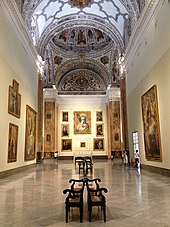
The most important art collection of Seville is the Museum of Fine Arts of Seville. It was established in 1835 in the former Convent ofLa Merced.It holds many masterworks byMurillo,Pacheco,Zurbarán,Valdés Leal,and others masters of the Baroque Sevillian School, containing also Flemish paintings of the 15th and 16th centuries.

Other museums in Seville are:
- TheArcheological Museum of Seville,which contains collections from theTartessian,Roman, Almohad, and Christian periods. It is located atPlazaAméricainParque de María Luisa.
- TheMuseum of Arts and Popular Customs of Seville,also inPlazaAmérica,across from the Archaeological Museum.
- TheAndalusian Contemporary Art Centre,situated in the neighbourhood ofLa Cartuja.
- The Naval Museum, housed in the Torre del Oro, next to the River Guadalquivir.
- The Carriages Museum, in the Los Remedios neighbourhood.
- TheFlamencoArt Museum
- TheBullfightingMuseum, in the Maestranza bullring.
- The Palace of the Countess of Lebrija, a private collection that contains many of the mosaic floors discovered in the nearby Roman town of Italica.
- TheCentroVelázquez(Velázquez Centre) located at the Old Priests Hospital in the touristic Santa Cruz neighbourhood.
- TheAntiquariumin Metropol Parasol, an underground museum which is composed of the most important archaeological site of the ancient Roman stage of Seville and remains preserved.
- TheCastillo de San Jorge(Castle of St. George) is situated near the Triana market, next to the Isabel II bridge. It was the last seat for the Spanish Inquisition.
- The Museum and Treasure ofLa Macarena,where the collection of theMacarena brotherhoodis exhibited. This exhibition gives visitors an accurate impression of Seville'sHoly Week.
- La Casa de la Ciencia(The House of Science), a science centre and museum opposite the María Luisa Park.
- Museum of Pottery in Triana.
- Pabellon de la Navegación(Pavilion of Navigation).
Other parks and gardens
[edit]In addition to the large Parque de María Luisa, the city contains other parks and gardens, including:
- The Alcázar Gardens, within the grounds of the Alcázar palace, consist of several sectors developed in different historical styles.
- The Gardens of Murillo and the Gardens of Catalina de Ribera, both along and outside the south wall of the Alcázar, lie next to the Santa Cruz quarter.
- TheParque del Alamillo y San Jerónimo,the largest park in Andalusia, was originally built forSeville Expo '92to reproduce the Andalusian native flora. It lines both Guadalquivir shores around theSan Jerónimomeander.The 32-metres-high bronze sculpture,The Birth of a New Man(popularly known as Columbus's Egg,el Huevo de Colón), by the Georgian sculptorZurab Tsereteli,[133]is located in its northwestern sector.
- The American Garden, also completed for Expo '92, is inLa Cartuja.It is a public botanical garden, with a representative collection of American plants donated by different countries on the occasion of the world exposition. Despite its extraordinary botanical value, it remains a mostly abandoned place.
- TheBuhaira Gardens,also historically known as theHuerta del Rey,are a public park and historic site, originally created as a garden estate during the Almohad period (12th century).[134][135]: 211
Culture
[edit]Theatres
[edit]
TheTeatro Lope de Vegais located on Avenida de María Luisa avenue (next toParque de María Luisa). It was built in 1929, being its architectVicente Traver y Tomás.It was the auditorium of the pavilion of the city in the Ibero-American Exhibition. This pavilion had a large room that became the Casino of the Exhibition. The theatre occupied an area of 4600 m2and could accommodate 1100 viewers. Its architecture isSpanish Baroque Revival,being the building faithful to this style both in the set and in its ornamentation.
It has hosted varied performances, including theater, dance, opera,jazz,andflamencoand nowadays the most outstanding of the panorama is its programming national and international, becoming one of the most important theatres in Spain.[136]
Other important theatres areTeatro de la Maestranza,Auditorio Rocío Jurado and Teatro Central.
Seville also has acorral de comediastheatre, which is theCorral del Coliseo,now used as a residential building.
Festivals
[edit]There are many entertainment options around the city of Seville and one of its biggest attractions is the numerous festivals that happen around the year. Some of the festivals concentrate on religion and culture, others focus on the folklore of the area, traditions, and entertainment.[137]
Holy Week in Seville
[edit]
Semana Santa is celebrated all over Spain and Latin America, but the celebration in Seville is large and well known as a Fiesta of International Tourist Interest. 54 local brotherhoods,[138]or "cofradías", organize floats and processions throughout the week, reenacting the story of the Passion of Christ. There is traditional music and art incorporated into the processions, making Semana Santa an important source of both material and immaterial Sevillian cultural identity.[139][140][141]
Bienal de Flamenco
[edit]Seville is home to the bi-annual flamenco festival La Bienal, which claims to be "the biggest flamenco event worldwide" and lasts for nearly a month.[142]
Velá de Santiago y Santa Ana
[edit]In the district of Triana, the Velá de Santiago y Santa Ana is held every July and includes sporting events, performances, and cultural activities as the city honors St. James and St. Ana.[143]
Feria de Abril
[edit]
The April Fair (Feria de Abril) is a huge celebration that takes place in Seville about two weeks after the Holy Week. It was previously associated with celebrating livestock; however, nowadays its purpose is to create a fun cheerful environment tied to the appreciation of the Spanish folklore.[144]
During the Feria, families, businesses, and organisations set upcasetas(marquees) in which they spend the week dancing, drinking, and socialising. Traditionally, women wear elaborate flamenco dresses and men dress in their best suits. The marquees are set up on a permanent fairground in the district of Los Remedios,[145]in which each street is named after a famous bullfighter.
Salón Náutico Internacional de Sevilla
[edit]The International Boat Show of Seville is an annual event that takes place in the only inland maritime port of the country, which is one of the most important in Europe.[146]
Music
[edit]
Seville had a vibrant rock music scene in the 1970s and 1980s[148]with bands likeTriana,AlamedaandSmash,who fused Andalusia's traditional flamenco music with British-style progressive rock. The punk rock groupReincidentesand indie bandSr Chinarro,as well as singerKiko Veneno,rose to prominence in the early 1990s. The city's music scene now features rap acts such asSFDK,Mala Rodríguez,Dareysteel,Tote King,Dogma Crew,Bisley DeMarra,HazeandJesuly.Seville's diverse music scene is reflected in the variety of its club-centred nightlife.
The city is also home to many theatres and performance spaces where classical music is performed, includingTeatro Lope de Vega,Teatro La Maestranza,Teatro Central, theReal Alcazar Gardensand the Sala Joaquín Turina.
Despite its name, thesevillanadance, commonly presented as flamenco, is not thought to be of Sevillan origin. However, the folksongs calledsevillanasare authentically Sevillan, as is the four-part dance performed with them.
On 19 November 2023, Seville hosted the24th Annual Latin Grammy Awardsat theFIBES Conference and Exhibition Centre,making Seville the first city outside of theUnited Statesto host theLatin Grammy Awards.[149][150]
Flamenco
[edit]
TheTrianadistrict in Seville is considered a birthplace of flamenco, where it found its beginning as an expression of the poor and marginalized. Seville's Gypsy population, known as Flamencos, were instrumental in the development of the art form. While it began as and remains a representation of Andalusian culture, it has also become a national heritage symbol of Spain.[151][152][153][154] There are more flamenco artists in Seville than anywhere else in the country, supporting an entire industry surrounding it and drawing in a significant amount of tourism for the city.[155]
Gastronomy
[edit]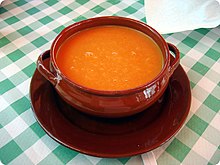
Thetapasscene is one of the main cultural attractions of the city: people go from one bar to another, enjoying small dishes called tapas (literally "lids" or "covers" in Spanish, referring to their probable origin as snacks served on small plates used to cover drinks). Local specialities include fried and grilled seafood (includingsquid,choco(cuttlefish),swordfish,marinateddogfish,andortiguillas), grilled and stewed meat,spinachwithchickpeas,Jamón ibérico,lamb kidneys in sherry sauce,snails,caldo de puchero,andgazpacho.A sandwich known as aserranitois the typical and popular version of fast food.
Typical desserts from Seville includepestiños,a honey-coated sweet fritter;torrijas,fried slices of bread with honey;roscos fritos,deep-fried sugar-coated ring doughnuts;magdalenasor fairy cakes;yemas de San Leandro,[citation needed]which provide the city'sconventswith a source of revenue; andtortas de aceite,a thin sugar-coated cake made with olive oil.Polvoronesandmantecadosare traditional Christmas products, whereaspestiñosandtorrijasare typically consumed during theHoly Week.
BitterSeville orangesgrow on trees lining the city streets. Large quantities are collected and exported to Britain to be used inmarmalade.[156]Locally, the fruit is used predominantly in aromatherapy, herbal medicine, and dietary diet products, rather than as a foodstuff.[157]According to legend, the Arabs brought the bitter orange to Seville from East Asia via Iraq around the 10th century to beautify and perfume their patios and gardens, as well as to provide shade.[158]The flowers of the tree are a source ofneroli oil,commonly used inperfumeryand in skin lotions for massage.
In 2021, the municipal water company, Emasesa, began a pilot scheme to use the methane produced as the fruit ferments to generate clean electricity. The company plans to use 35 tonnes of fruit to generate clean energy to power one of the city's water purification plants.[159]
Economy
[edit]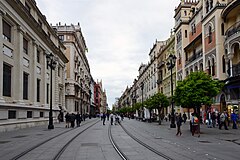
Seville is the most populated city in southern Spain, and has the largest GDP (gross domestic product) of any in Andalusia,[160]accounting for one-quarter of its total GDP.[160]All municipalities in the metropolitan area depend directly or indirectly on Seville's economy, while agriculture dominates the economy of the smaller villages, with some industrial activity localised in industrial parks. TheDiputación de Sevilla(Deputation of Seville), with provincial headquarters in the Antiguo Cuartel de Caballería (Old Cavalry Barracks) on Avenida Menendez Pelayo, provides public services to distant villages that they can not provide themselves.[161]
The economic activity of Seville cannot be detached from the geographical and urban context of the city; the capital of Andalusia is the centre of a growing metropolitan area. Aside from traditional neighbourhoods such as Santa Cruz, Triana and others, those further away from the centre, such asNervión,Sevilla Este, and El Porvenir have seen recent economic growth. Until the economic crisis of 2007, this urban area saw significant population growth and the development of new industrial and commercial parks.[162]
During this period, availability of infrastructure in the city contributed to the growth of an economy dominated by the service sector,[163]but in which industry still holds a considerable place.[164]
Infrastructure
[edit]
The 1990s saw massive growth in investment in infrastructure in Seville, largely due to its hosting of theUniversal Exposition of Sevillein 1992. This economic development of the city and its urban area is supported by good transportation links to other Spanish cities, including a high-speedAVErailway connection to Madrid, and a new internationalairport.
Seville has the only inland port in Spain, located 80 km (50 mi) from the mouth of the River Guadalquivir. This harbour complex offers access to the Atlantic and the Mediterranean and allows trade in goods between the south of Spain (Andalusia,Extremadura) and Europe, the Middle East and North Africa. The port has undergone reorganisation. Annualtonnagerose to 5.3 million tonnes of goods in 2006.[165]
Cartuja 93is a research and development park,[166]employing 15,000 persons. TheParque Tecnológico y Aeronáutico Aerópolis(Technological and Aeronautical Park)[167]is focused on the aircraft industry. Outside of Seville are ninePS20 solar power towerswhich use the city's sunny weather to provide most of it with clean and renewable energy.
TheSevilla Towerskyscraper was started in March 2008 and was completed in 2015. With a height of 180.5 metres (592 feet) and 40floors,it is the tallest building inAndalusia.
Seville has conference facilities, including theConference and Convention Centre.

Research and development
[edit]TheConsejo Superior de Investigaciones Científicas en Sevilla(CSIC) is based in the formerPavilion of Peruin theMaria Luisa Park.In April 2008 the city council of Seville provided a grant to renovate the building to create theCasa de la Ciencia(Science Centre) to encourage popular interest in science.[168]The internationally recognised companyNeocodexhas its headquarters in Seville; it maintains the first and largestDNA bankin Spain and has made significant contributions to scientific research in genetics.[169]Seville is also considered an important technological and research centre for renewable energy and the aeronautics industry.[170][171]
The output of the research centres in Sevillan universities working in tandem with city government, and the numerous local technology companies, have made Seville a leader among Spanish cities in technologicalresearch and development.TheParque Científico Tecnológico Cartuja 93is a nexus of private and public investment in various fields of research.[172]
Principal fields of innovation and research are telecommunications, new technologies, biotechnology (with applications in local agricultural practices), environment and renewable energy.
Transport
[edit]Bus
[edit]Seville is served by the TUSSAM(Transportes Urbanos de Sevilla)busnetwork which runs buses throughout the city. The Consorcio de Transportes de Sevilla communicates by bus with all the satellite towns of Seville.
Two bus stations serve transportation between surrounding areas and other cities:Plaza de ArmasStation, with destinations north and west, andPrado de San SebastiánStation, covering routes to the south and east.Plaza de Armasstation has direct bus lines to many Spanish cities as well asLisbon,Portugal.
Metro
[edit]TheSeville Metro( "Metro de Sevilla" in Spanish) is a light metro network serving the city of Seville and itsmetropolitan area.The system is totally independent of any other rail or street traffic. All stations were built withplatform screen doors.
It was the sixth Metro system to be built in Spain, after those inMadrid,Barcelona,Valencia,BilbaoandPalma de Mallorca.Currently, it is the fifth-biggest Metro company in Spain by the number of passengers carried (more than 12,000,000 in 2009).[173]
The metro of Sevilla has 1 line with 22 stations and is currently expanding, with 3 more different lines projected.[citation needed]
Tram
[edit]
MetroCentrois a surface tramway serving the centre of the city. It began operating in October 2007.
The service has just five stops: Plaza Nueva, Archivo de Indias, Puerta de Jerez, Prado de San Sebastián and San Bernardo, all as part ofPhase Iof the project. It is expected to be extended to Santa JustaAVEstation, including four new stops: San Francisco Javier, Eduardo Dato, Luis de Morales, and Santa Justa. This extension was postponed although the City Council had made expanding the metro lines a priority.[citation needed]
Train
[edit]TheSeville-Santa Justa railway stationis served by theAVEhigh-speed railsystem, operated by the Spanish state-owned rail companyRenfe.A five-line commuter rail service (Cercanías) joins the city with the Metropolitan area. Seville is on the Red Ciudades AVE, a net created with Seville connected to 17 major cities of Spain withhigh-speed rail.
Although Seville is close to the Portuguese city ofFaro,it is not possible to cross the border by train.[174]
Bicycle
[edit]
The Sevicicommunity bicycle programhas integrated bicycles into the public transport network. Bicycles are available for hire around the city at low cost, and green curb-raised bicycle lanes can be seen on most major streets. The number of people using bicycles as a means of transport in Seville has increased substantially in recent years, multiplying tenfold from 2006 to 2011.[175]As of 2015[update],an estimated 9 percent of all mechanized trips in the city (and 5.6 percent of all trips including those on foot) are made by bicycle.[176]
The city council signed a contract with the multinational corporationJCDecaux,an outdoor advertising company. The public bicycle rental system is financed by a local advertising operator in return for the city signing over a 10-year licence to exploit citywide billboards. The overall scheme is called Cyclocity[177]byJCDecaux,but each city's system is branded under an individual name.
As of 2022, some companies in thee-bikecommunity bicycle programindustry such asLime (transportation company)andRidemovistarted working in the city,[178]thanks to the new parking spots made by theCity Council of Seville
Airport
[edit]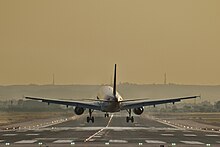
The San Pablo Airport is the main airport for Seville and isAndalusia's second busiest airport, afterMálaga's, and first in cargo. The airport handled 7,544,357 passengers and just under 9,891 tonnes of cargo in 2019.[179]It has oneterminaland onerunway.
It is one of many bases for the Spanish low-cost carrierVueling,and from November 2010Ryanairbased aircraft at the airport.[180][needs update]In addition, Ryanair opened its firstaircraft maintenancefacility in Spain at Seville Airport in 2019.[181]
This enabled low-cost direct flights to several Spanish cities, as well as to the neighbor country of Portugal with weekly flights to Porto[182]and to other European cities.
Port
[edit]Seville is the only commercial river port in Spain and the only inland city in the country where cruise ships can arrive in the historical centre. On 21 August 2012, the Muelle de las Delicias, controlled by the Port Authority of Seville, hosted the cruise shipAzamara Journeyfor two days, the largest ship ever to visit the town. This vessel belongs to the shipping companyRoyal Caribbeanand can accommodate up to 700 passengers.[183]
Roads
[edit]Seville has one ring road, the SE-30, which connects with the dual carriageway of the south, the A-4, that directly communicates the city withCádiz,CordobaandMadrid.Also there is another dual carriageway, the A-92, linking the city withOsuna,Antequera,Granada,GuadixandAlmeria.The A-49 links Seville withHuelvaand theAlgarvein the south ofPortugal.
Public transportation statistics
[edit]The average amount of time people spend commuting with public transit in Sevilla, for example to and from work, on a weekday is 34 min. 7% of public transit riders, ride for more than two hours every day. The average amount of time people wait at a stop or station for public transit is eight minutes, while 15% of riders wait for over 20 minutes on average every day. The average distance people usually ride in a single trip with public transit is 5.6 kilometres (3.5 mi), while 7% travel for over 12 kilometres (7.5 mi) in a single direction.[184]
Education
[edit]Seville is home to three public universities. TheUniversity of Seville(US), founded in 1505; as of 2019, it had 72,000 students.[185]ThePablo de Olavide University(UPO), founded in 1997, with 9,152 students in 2019;[186]and theInternational University of Andalusia(UNIA), founded in 1994.[187]
The US and the UPO are important centres of learning in Western Andalusia as they offer a wide range of academic courses; consequently, the city has a large number of students fromHuelvaandCádiz.
Additionally, there is the School of Hispanic American Studies, founded in 1942, theMenéndez Pelayo International University,based inSantander,which operates branch campuses in Seville, andLoyola University Andalusia.[188]
- International primary and secondary schools
- Lycée Français de Séville(French school)
- Deutsche Schule Sevilla(German school)
- St. George's British School
Seville is also home to many international schools and colleges that cater to American students who come to study abroad.
Sport
[edit]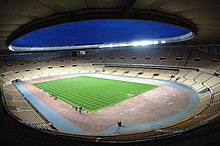
Seville is the hometown of two rival association football teams:Real Betis BalompiéandSevilla Fútbol Club;both teams play inLa Liga.Each team has won the league once: Betis in 1935 and Sevilla in 1946.[189]Only Sevilla have won European competitions, winning consecutiveUEFA Cupfinals in2006and2007[190]and theUEFA Europa Leaguein2014,[191]2015,2016,2020and2023.TheRamón Sánchez PizjuánandBenito Villamarín,stadiums of Sevilla and Betis respectively, were venues for the1982 FIFA World Cup.[192]Sevilla's stadium also hosted the1986 European Cup final[193]and the multi-purpose stadium built in 1999La Cartuja,was the venue for the2003 UEFA Cup final.[194]Seville has anACB Leaguebasketball club, theReal Betis Baloncesto.
Seville has hosted bothindoor(1991) andoutdoor(1999) World Championships in athletics, while housed the tennisDavis Cupfinal in2004and2011.The city unsuccessfully bid for the2004[195]and2008 Summer Olympics,[196]for which the 60,000-seatEstadio de La Cartujawas designed to stage. Seville's River Guadalquivir is one of only threeFISAapproved international training centres forrowingand the only one in Spain; the2002 World Rowing Championshipsand the2013 European Rowing Championshipswere held there.
In fiction
[edit]- Thepicaresque novelRinconete y Cortadilloby Miguel de Cervantes takes place in the city of Seville.
- The novelLa Femme et le pantin(The Woman and the Puppet) (1898) byPierre Louÿs,adapted for film several times, is set mainly in Seville.
- Seville is the setting for the legend ofDon Juan(inspired by the real aristocratDon Miguel de Mañara) on thePaseo Alcalde Marqués de Contadero.
- Seville is the primary setting of many operas, the best known of which areBizet'sCarmen(based onMérimée'snovella),Rossini'sThe Barber of Seville,Verdi'sLa forza del destino,Beethoven'sFidelio,Mozart'sDon GiovanniandThe Marriage of Figaro,andProkofiev'sBetrothal in a Monastery.
- Seville is the setting of the novelThe Seville CommunionbyArturo Pérez-Reverte.
- Seville is both the location and setting for much of the 1985Doctor Whotelevision serial "The Two Doctors".
- Seville is also used as one of the locations in Dan Brown'sDigital Fortress.
- Seville is one of the settings inJostein Gaarder's bookThe Orange Girl(Appelsinpiken).
- Seville is the hometown of the two main characters in the 2000 filmThe Road to El DoradobyDreamWorks.Miguel and Tulio are con artists that stow away on a ship bound for theNew Worldand win a map for the fabled lost city of gold,El Dorado,and are invariably seen as gods by the locals.
- Arthur Koestler's bookSpanish Testamentis based on the writer's experiences while held in the Seville prison, under a sentence of death, during theSpanish Civil War.
- Robert Wilson'spolice novelThe Hidden Assassins(2006) concerns a terrorist incident in Seville and the political context thereof, with much local colour.
- ThePlaza de Españain theParque de María Luisaappears in George Lucas'Star Wars: Episode II – Attack of the Clones,inThe Dictator,starringSacha Baron Cohen,as the palace of the dictatorAladeen,and inLawrence of Arabiaas the British Army headquarters inCairo,while the courtyard was theKing Alfonso XIII Hotel.
- ThePlaza of the Americasalso appeared inLawrence,substituting forJerusalem,and inAnthony Mann'sEl Cid.It also appears as the Palace ofVladek Sheybal's Bashaw inThe Wind and the Lion(1975).
- TheAlcázarand other sites appear in the television seriesGame of Thrones,in the cities of Dorne.
- In the 2016 filmAssassin's Creed,Master Assassins Aguilar de Nerha and Maria escape execution and are pursued by Templars through the city, eventually performing Leaps of Faith off of an unfinished Seville Cathedral to escape.
- InMission: Impossible 2,Ethan Hunt is sent to Seville to recruit Nyah Nordoff-Hall.
In travel writing
[edit]- The Tomb in SevillebyNorman Lewis.
Twin towns – sister cities
[edit]Seville istwinnedwith the following cities:
 Angers(France), 1989.[197]
Angers(France), 1989.[197] Barcelona(Spain), 1987.[197][198]
Barcelona(Spain), 1987.[197][198] Buenos Aires(Argentina), 1976.[197][199]
Buenos Aires(Argentina), 1976.[197][199] Columbus, Ohio(United States), 1988.[197][200]
Columbus, Ohio(United States), 1988.[197][200] Córdoba(Spain), 1908.[197]
Córdoba(Spain), 1908.[197] Guadalajara(Mexico), 1984.[197]
Guadalajara(Mexico), 1984.[197] Havana(Cuba), 2007.[197][199][201][202]
Havana(Cuba), 2007.[197][199][201][202] Kansas City, Missouri(United States), 1969. The relationship between Seville and Kansas City is due to a small replica of the Giralda tower, Sevilla's cathedral belltower, that exists in Kansas City.[203][204]
Kansas City, Missouri(United States), 1969. The relationship between Seville and Kansas City is due to a small replica of the Giralda tower, Sevilla's cathedral belltower, that exists in Kansas City.[203][204] Laredo(Spain), 2017.[205]
Laredo(Spain), 2017.[205] Marrakech(Morocco), 2017.[206]
Marrakech(Morocco), 2017.[206] Medina de Rioseco(Spain), 2016.[207]
Medina de Rioseco(Spain), 2016.[207] San Salvador(El Salvador), 2018.[208]
San Salvador(El Salvador), 2018.[208] Sevilla la Nueva(Spain).[197]
Sevilla la Nueva(Spain).[197]
- Partnerships
Titles
[edit]Seville has been given titles by Spanish monarchs and heads of state throughout its history.[210]
- Very Noble,by King Ferdinand III of Castile after his reconquest of the city.
- Very Loyal,by KingAlfonso X of Castilefor supporting him against a rebellion. See also the Motto "NO8DO".
- Very Heroic,by KingFerdinand VII of Spainby Royal Document on 13 October 1817 for support against the French invasion.
- Invictus(Invincible inLatin), by QueenIsabella II of Spainfor the city's resistance against General Van Halen's asedium and bombing in 1843.
- Mariana,by GeneralFrancisco Francoin 1946 for the city's devotion to the Virgin Mary.
Notable people
[edit]Historical
[edit]- Maria Antonietta of Spain,Queen consort of Sardinia(1729–1785)
- Al-Mu'tamid ibn Abbad, poet and Arabic king of Sevilla 1040–1095
- PhysicianAvenzoar
- The family of the Arabic historian and sociologistIbn Khaldun
- 13th-century poetIbn Sahl of Seville
- Luis del Alcázar,aJesuittheologian, (1554–1613)
- Renaissance composersCristóbal de Morales,Francisco Guerrero
- 16th-century novelistMateo Alemán
- PlaywrightsLope de Rueda[211]andHermanos Alvarez Quintero
- Historian ofNew SpainBartolomé de Las Casas
- Colonial governor of La Florida and Cuba:Laureano de Torres y Ayala
- Colonial governor of La Florida:Pablo de Hita y Salazar
- Baroque paintersDiego Velázquez,Valdés LealandBartolomé Esteban Murillo
- EducatorAdelita Domingo
- Explorer and astronomerAntonio de Ulloa
- RenaissancepoetsFernando de HerreraandGutierre de Cetina
- Notable Costumbrista painter who liked to depict the 19th century society of Seville and its buildingsJosé Jiménez Aranda
- Romantic poetGustavo Adolfo Bécquer[211]
- BullfightersJuan Belmonte,Curro Romero,Ignacio Sánchez Mejías,Emilio MuñozandJosé Gómez Ortega
- Second Spanish RepublicPrime MinisterDiego Martinez,communist politicianJosé Díazand Carlist politicianManuel Fal.
20th-century artists
[edit]- Vicente Aleixandre(Nobel Laureate)
- AntonioandManuel Machado
- Luis Cernuda
- ComposerJoaquín Turina
- Drag queenCarmen Farala,winner of thefirst seasonofDrag Race España
- CartoonistWilliam Haselden
- ActorsJuan Diego,Paco León
- ActressesSoledad Miranda,Verónica Sánchez,Carmen Sevilla,[211]Paz Vega,[211]Azucena Hernández
- El Risitas,humorist
- ComedianManuel Summers
- EmbroidererEsperanza Elena Caro
- Maria Pages,dancer
- Jairo Barrull Fernández,SpanishGypsyflamenco dancer
Models
[edit]- Teresa Sánchez Lópezwho won the title of Miss National in theMiss Spaincontest 1984 and, representing Spain, was close to the crown ofMiss Universein 1985 (1st runner up).
- Eva Maria Gonzálezbeauty queen and model who wasMiss España2003 (representing Andalusia)
Singers
[edit]- Isabel Pantoja
- Juanita Reina
- Lole y Manuel
- Paquita Rico
- El Caracol
- Falete
- Pastora Soler
- Mala Rodríguez
Athletes
[edit]- Association footballersJosé Antonio Reyes,Fernando "Nando" Muñoz,Ricardo Serna,Sergio Ramos,Jesús Navas,Antonio Puerta,Carlos Marchena,Jesús Capitán "Capi",Adrián,Olga Carmona,Irene Guerrero
- Olympic swimmerFátima Madrid
Other notable people
[edit]- Navy officerMiguel Buiza Fernández-Palacioswho became Captain General of theSpanish Republican Navy
- PoliticiansFelipe González,President of the Government of Spainfrom 1982 to 1996, andAlfonso Guerra,vice-president from 1982 to 1991
- CriminalManuel Delgado Villegas,serial killer
- MysticBárbara de Santo Domingo
See also
[edit]- Azulejo
- Cadillac Seville,a car that was named after the city
- Church of Santa Maria la Blanca (Seville)
- Isla Mágica
- Seville Public Library
- Seville Statement on Violence
References
[edit]- ^Demographia: World Urban Areas,2022
- ^"Gross domestic product (GDP) at current market prices by metropolitan regions".ec.europa.eu.
- ^Staff (2020)."Seville, Spain".earth.esa.int.ESA Earth Online 2000 - 2020. Archived fromthe originalon 21 March 2020.Retrieved21 March2020.
- ^Christian-Muslim Relations. A Bibliographical History. Volume 4 (1200–1350).Brill. 2012. p. 9.ISBN978-90-04-22854-2.Retrieved7 February2013.
- ^Pachecho Morales-Padrón, Marcos (2021)."La organización portuaria del golfo de Cádiz en los siglos XVI y XVII: el Arenal de Sevilla y sus antepuertos".Chronica Nova.47.Granada:Editorial Universidad de Granada:430–431.doi:10.30827/cnova.v0i47.7672.ISSN0210-9611.
- ^SPAL: Revista de prehistoria y arqueología de la Universidad de Sevilla.Secretariado de Publicaciones de la Universidad de Sevilla. 1998. p. 93.Retrieved8 February2013.
La presencia de fenicios en la antigua Sevilla parece constatada por el topónimo Spal que en diversas lenguas semíticas significa "zona baja", "llanura verde" o "valle profundo"
- ^"La Emergencia de Sevilla".Universidad de Sevilla.Retrieved11 May2011.
- ^Harper, Douglas."Seville".Online Etymology Dictionary.Retrieved21 September2024.
- ^De Coripe a Sevilla por Utrera: formación y deformación de topónimos en el habla.Diputación de Sevilla. 2013.ISBN978-84-940980-0-0.Archived fromthe originalon 24 February 2021.Retrieved11 September2018.
- ^abcJosé María de Mena (1992).Art and History of Seville.Casa Editrice Bonechi. p. 6.ISBN978-88-7009-851-8.
- ^Echevarria, Ana (2008).Biografías mudéjares, o, La experiencia de ser minoría: biografías islámicas en la España cristiana.Consejo Superior de Investigaciones Científicas. p. 394.ISBN978-84-00-08744-9.
- ^Gerber, Jane S. (1992).The Jews of Spain.Simon and Schuster. p. 31.ISBN978-1-4391-0783-6.
- ^José María de Mena Plaza & Janés (1985).Historia de Sevilla.Plaza & Janés. p. 47.ISBN978-84-01-37200-1.
- ^Calvert (2018).Southern Spain.BoD – Books on Demand. p. 17.ISBN978-3-7340-3692-7.
- ^Manrique, Nelson (1993).Vinieron los Sarracenos...: el universo mental de la conquista de América.DESCO. p. 178.ISBN978-84-89312-04-3.
- ^Glick, Thomas F. (2005).Islamic And Christian Spain in the Early Middle Ages.BRILL. p. 48.ISBN90-04-14771-3.
- ^Glick, Thomas F. (1979).Islamic and Christian Spain in the Early Middle Ages.Princeton University Press. p. 323.ISBN978-0-7837-0098-4.
- ^El Gharbi, Jalel (2009)."Thrène de Séville".Cahiers de la Méditerranée(in French) (79): 26–30.doi:10.4000/cdlm.4901.
- ^"Leyendas de Sevilla – 5 Hércules y la fundación de Sevilla".Aznalfarache.blogspot.com.13 September 2010.Retrieved29 February2012.
- ^Manuel Jesús Roldán Salgueiro (2007).Historia de Sevilla.Almuzara.ISBN978-84-88586-24-7.Retrieved9 February2013.
- ^José María de Mena (1985).Historia de Sevilla.Plaza & Janés. p. 39.ISBN978-84-01-37200-1.Retrieved9 February2013.
- ^"Proyecto Puntual de Investigación 1999: Intervención Puntual:" Estudios estratigráficos y análisis constructivos "".Real Alcázar(in Spanish). Real Alcázar de Sevilla. Archived fromthe originalon 17 March 2015.Retrieved13 November2017.
Los restos antrópicos más antiguos se situaban sobre esta terraza, bajo la muralla Septentrional del Alcázar, datados en el s. VII-VIII a.C.
- ^Elizabeth Nash (16 September 2005).Seville, Cordoba, and Granada: A Cultural History: A Cultural History.Oxford University Press, USA. p. 8.ISBN978-0-19-972537-3.
- ^"Antiguas Murallas y Puertas de Sevilla".Degelo.com.Retrieved12 March2012.
- ^abcGonzález Athané, José (2012)."La influencia del río Guadalquivir en la imagen de la ciudad de Sevilla a lo largo de los siglos"(PDF).Paisajes modelados por el agua: entre el arte y la ingeniería.p. 102.ISBN978-84-9852-345-4.Archived(PDF)from the original on 9 October 2022.
- ^Calvo Capilla, Susana (2007)."Las primeras mezquitas de al-Andalus a través de las fuentes árabes (92/711 – 170/785)".Al-Qanṭara.28(1). Madrid:Ediciones CSIC:167.doi:10.3989/alqantara.2007.v28.i1.34.
- ^Scheen, Rolf (1996)."Viking raids on the spanish peninsula".Militaria: Revista de Cultura Militar(8). Madrid:Ediciones Complutense:67.ISSN0214-8765.
- ^Valencia 1994,p. 136–137; 138.
- ^Valencia, Rafael (1994)."Islamic Seville: Its Political, Social and Cultural History".In Jayyusi, Salma Khadra (ed.).The Legacy of Muslim Spain(2nd ed.). Leiden, New York, Köln:EJ Brill.p. 138.ISBN90-04-09599-3.
- ^García Sanjuán, Alejandro (2004)."Declive y extinción de la minoría cristiana en la Sevilla andalusí (ss. XI-XII)"(PDF).Historia. Instituciones. Documentos(31): 271–276.ISSN0210-7716.Archived(PDF)from the original on 9 October 2022.
- ^abcValencia 1994,p. 139.
- ^Valor Piechotta, Magdalena; Lafuente Ibáñez, Pilar (2018)."La Sevilla 'abbādí"(PDF).In Sarr, Bilal (ed.).Tawa'if. Historia y Arqueología de los reinos taifas.Granada. p. 182.ISBN978-84-949380-2-3.
{{cite book}}:CS1 maint: location missing publisher (link) - ^El Hour 1999,p. 289.
- ^Ramírez del Río, José (1999)."Pueblos de Sevilla en época islámica. Breve recorrido histórico-político"(PDF).Philologia Hispalensis.13(1): 19.Archived(PDF)from the original on 9 October 2022.
- ^El Hour, Rachid (1999)."La transición entre las épocas almorávide y almohade vista a través de las familias de ulemas"(PDF).Estudios onomástico-biográficos de al-Andalus, IX.Consejo Superior de Investigaciones Científicas.p. 291.ISBN84-00-07860-8.Archived(PDF)from the original on 9 October 2022.
- ^Domínguez Berenjeno, Enrique Luis (2001)."La remodelación urbana de Ishbilia a través de la historiografía almohade"(PDF).Actas de las II Jornadas Cordobesas de Arqueología Andaluza(12). Córdoba:UCOPress:178–179.doi:10.21071/aac.v0i.11252(inactive 12 September 2024).
{{cite journal}}:CS1 maint: DOI inactive as of September 2024 (link) - ^Buresi, Pascal (2017)."The story of the Almohads in the Kingdom of Fez and of Morocco".The Soul of Morocco.pp. 105–146.
- ^García-Sanjuan, Alejandro (2020). "Box 2.1 Seville". In Fierro, Maribel (ed.).The Routledge Handbook of Muslim Iberia.Routledge.pp. 23–25.ISBN978-1-315-62595-9.
- ^Ladero Quesada, Miguel Ángel (1987)."Las ciudades de Andalucía occidental en la Baja Edad Media: sociedad, morfología y funciones urbanas".En la España medieval.10.Madrid:Ediciones Complutense:74.ISSN0214-3038.
- ^Mott, Lawrence V. (2002)."Iberian Naval Power, 1000–1650"(PDF).In Hattendorf, John B.; Unger, Richard W. (eds.).War at Sea in the Middle Ages and the Renaissance.Boydell & Brewer.p. 107.ISBN978-1-84615-171-2.Archived(PDF)from the original on 9 October 2022.
- ^Joseph F. O'Callaghan (1975).A History of Medieval Spain.Cornell University Press. p. 353.ISBN978-0-8014-9264-8.Retrieved6 February2013.
- ^García Sanjuán, Alejandro (2017)."La conquista de Sevilla por Fernando III (646 h/1248). Nuevas propuestas a través de la relectura de las fuentes árabes".Hispania. Revista Española de Historia.LXXVII(255). Madrid:Editorial CSIC:31–33.doi:10.3989/hispania.2017.001.hdl:10272/15574.ISSN0018-2141.
- ^John Julius Norwich (1 April 2001).Great Architecture of the World.Da Capo Press, Incorporated. p. 271.ISBN978-0-306-81042-8.Retrieved15 May2013.
- ^Longhurst, john Edward (1 January 1964)."The Age of Torquemada, Chapter 6, pg. 79".Coronado Press.Retrieved22 August2021.Description of Dominican friar who agitated for the Spanish Inquisition.
- ^MacKay, A. (1972). "Popular Movements and Pogroms in Fifteenth-Century Castile".Past and Present(55): 33–67.doi:10.1093/past/55.1.33.
- ^Levine Melammed, Renee. "Women in Medieval Jewish Societies."Women and Judaism: New Insights and Scholarship.Ed. Frederick E. Greenspahn. New York: New York University Press, 2009. 105–106.
- ^Pérez-Mallaína 1997,p. 15.
- ^Pérez-Mallaína 1997,p. 16.
- ^Pérez-Mallaína, Pablo E. (1997)."Auge y decadencia del puerto de Sevilla como cabecera de las rutas indianas".Caravelle. Cahiers du monde hispanique et luso-brésilien.69:15–16.doi:10.3406/carav.1997.2753.hdl:11441/101782.
- ^Pacheco Morales-Padrón 2021,pp. 408–409.
- ^"Demografía de Sevilla en el siglo XVI".Seville University.Retrieved23 July2012.
- ^Nash, Elizabeth (13 October 2005).Seville, Cordoba, and Granada: A Cultural History.Oxford University Press.ISBN978-0-19-518204-0.
- ^"Chapter 15: A History of Spain and Portugal".libro.uca.edu.Retrieved27 April2019.
- ^"99.06.01: Human-Environment Relations: A Case Study of Donana National Park, Andalucia, Spain and the Los Frailes Mine Toxic Spill of 1998".Yale.edu.Retrieved10 April2011.
- ^Casey, James (2002).Early Modern Spain: A Social History.Routledge. pp. 37–38.ISBN978-1-134-62380-8.
- ^Byron Ellsworth Hamann,The Invention of the Colonial Americas: Data, Architecture, and the Archive of the Indies, 1781-1844.Los Angeles: Getty Publications 2022
- ^Hamann,The Invention of the Colonial Americas: Data, Architecture, and the Archive of the Indies, 1781-1844,1
- ^"Un campus, una ciudad".Universidad de Sevilla. Archived fromthe originalon 25 March 2014.Retrieved15 March2014.
- ^Mounielou, Jean Francois (21 February 2017)."Seville and the Opera, a true love affair".Terra Traditions. Archived fromthe originalon 22 May 2018.Retrieved20 May2018.
- ^Antigüedad del Castillo-Olivares, María Dolores (1990). "El arquitecto Melchor Cano y la teoría de la ciudad. Espacio, Tiempo y Forma".Historia del Arte.VII.3.Madrid: UNED: 417–439.
- ^Santiago Cirugeda; et al.Collectives Architectures.Vibok Works.ISBN978-84-939058-2-8.Retrieved2 February2013.
- ^"La UNIA acoge en Sevilla unas jornadas de arteypensamiento sobre Capital y Territorio".Universidad Internacional de Andalucía. Archived fromthe originalon 8 January 2014.Retrieved2 February2013.
- ^Diego A. Cardoso Bueno:Sevilla. El Casco Antiguo. Historia, Arte y Urbanismo.Ediciones Guadalquivir (2006).ISBN84-8093-154-X.Consultado el 24 March 2010
- ^Fernández Paradas, Mercedes;La implantación del alumbrado público de electricidad en la Andalucía del primer del tercio del S. XX,Universidad de Málaga, España [04-09-2012].
- ^Henry Robinson Luce (January 1929)."Time".Time.Vol. 13. p. 25.Retrieved6 February2013.
- ^abcThe Spanish Civil War,Hugh Thomas, Penguin, 1961, pp. 221–223,ISBN0-14-013593-6
- ^Noble, John; Forsyth, Susan; Maric, Vesna (1 January 2007).Lonely Planet Andalucia.Lonely Planet Publications.ISBN978-1-74059-973-3.Retrieved10 April2011– via Google Books.
- ^Stanley G. Payne (2008).Franco and Hitler: Spain, Germany, and World War II.Yale University Press. p. 123.ISBN978-0-300-12282-4.
- ^Wayne H. Bowen (2006).Spain During World War II.University of Missouri Press. p.25.ISBN978-0-8262-6515-9.
- ^Marshall Cavendish Corporation (January 2004).History of World War II.Marshall Cavendish. p. 611.ISBN978-0-7614-7482-1.
- ^Christian Pfister; Rudolf Brázdil; Rüdiger Glaser (14 March 2013).Climatic Variability in Sixteenth-Century Europe and Its Social Dimension.Springer Science & Business Media. p. 272.ISBN978-94-015-9259-8.
- ^"Muere Manuel del Valle, el exalcalde de Sevilla que rediseñó la ciudad".ABC.27 March 2020.Archivedfrom the original on 14 April 2020.Retrieved14 April2020.
- ^Rowan Moore."Metropol Parasol, Seville by Jürgen Mayer H – review | Art and design".The Guardian.Retrieved24 November2016.
- ^barba, eduardo (7 May 2012)."La factura final de las" setas "es de 102 millones, el doble de lo presupuestado".ABC de Sevilla.Retrieved2 March2016.
- ^"Metropol Parasol Urban Project in Seville".Andalucia.com.6 December 2011.Retrieved2 March2016.
- ^M. Kottek; J. Grieser; C. Beck; B. Rudolf; F. Rubel (2006)."World Map of the Köppen-Geiger climate classification updated"(PDF).Meteorol. Z.15(3): 259–263.Bibcode:2006MetZe..15..259K.doi:10.1127/0941-2948/2006/0130.Retrieved22 April2009.
- ^"Valores climatológicos normales. Sevilla Aeropuerto".AEMET.Retrieved3 April2022.
- ^"Europe's hottest spot? Let's have a heated debate".The Independent.17 August 2001.Retrieved22 May2022.
- ^Puentes, Carlos (22 August 2018)."La 'sartén' de España: una cuestión orográfica con acento cordobés".Cordópolis(in Spanish).Retrieved22 May2022.
- ^Bermejo, Nicolás (9 August 2018)."¿Por qué el valle del Guadalquivir es la" sartén "de España?".AEMETblog(in Spanish).Retrieved22 May2022.
- ^"CartujaQanat – Recovering the Street Life in a Climate Changing World Journal 2: How is Sevilla moving the needle in the fight to urban climate transformation".UIA Initiative.European Union.Archived from the original on 30 November 2021.Retrieved3 April2022.
{{cite web}}:CS1 maint: bot: original URL status unknown (link) - ^"Seville, Spain".European Space Agency.2022. Archived fromthe originalon 25 January 2021.Retrieved3 April2022.
- ^"¿Cuál es la ciudad más calurosa de España?".Cadena COPE.3 July 2021.Retrieved21 December2021.
- ^"Las ciudades donde hace más calor de España"(in Spanish).La Sexta.14 July 2016.Retrieved29 July2021.
- ^"AEMET OpenData".opendata.aemet.es.Retrieved14 January2024.
- ^"Heatwave Yago: Here's why Seville is naming its extreme heat events".euronews.26 June 2023.Retrieved8 January2024.
- ^"Sevilla Aeropuerto: Sevilla Aeropuerto - Valores extremos absolutos - Selector - Agencia Estatal de Meteorología - AEMET. Gobierno de España".Aemet.es(in Spanish).Retrieved3 April2022.
- ^"Highest Temperature Extremes".NOAA Satellite and Information Service. Archived fromthe originalon 28 November 2013.Retrieved29 August2012.
- ^"Bomberos de Sevilla. Alta protección y confort bajo condiciones climatológicas extremas"(PDF).asociacionceat.org(in Spanish).Archived(PDF)from the original on 9 October 2022.Retrieved3 April2022.
- ^"Sevilla cumple sesenta años sin ver la nieve en sus calles".ABC.Spain. 2 February 2014.
- ^"Últimas 10 nevadas sobre Sevilla".Foro de Tiempo.com.Retrieved7 October2018.
- ^"AEMET OpeenData".Agencia Estatal de Meteorologia.Retrieved12 May2024.
- ^"Seville Climate normals (only precipitation days, sunshine and humidity)"(CSV).NOAA.
- ^"Valores climatológicos normales. Sevilla Aeropuerto".AEMET.Retrieved21 December2021.
- ^"Valores extremos. Sevilla Aeropuerto".AEMET.Retrieved21 December2021.
- ^"Changes in the municipalities in the population census since 1842"(in Spanish).National Statistics Institute.
- ^Guaita Martínez, José Manuel; Martín Martín, José María; Salinas Fernández, Jose Antonio; Mogorrón-Guerrero, Helena (July 2019). "An analysis of the stability of rural tourism as a desired condition for sustainable tourism".Journal of Business Research.100:165–174.doi:10.1016/j.jbusres.2019.03.033.hdl:10481/87452.S2CID159374518.
- ^Quick, P. S. (2017).A Guide to Seville: Five Walking Tours.Andrews UK Limited.ISBN978-1-78538-646-6.
- ^Wertheimer, Lester (2004).Architectural History.Kaplan AEC Architecture. p. 48.ISBN978-0-7931-9380-6.
- ^Melton, J. Gordon; Baumann, Martin, eds. (2010).Religions of the World: A Comprehensive Encyclopedia of Beliefs and Practices, 2nd Edition.Vol. 2. ABC-CLIO. p. 517.ISBN978-1-59884-204-3.
- ^abcdHourihane, Colum, ed. (2012)."Seville".The Grove Encyclopedia of Medieval Art and Architecture.Oxford University Press. pp. 570–571.ISBN978-0-19-539536-5.
- ^Beding, Silvio A., ed. (2016).The Christopher Columbus Encyclopedia.Springer. p. 80.ISBN978-1-349-12573-9.
- ^Sánchez, Emilio Romero; Esteban, Antonio Morales; Casas, Jaime Navarro (2022)."Analysis of the Historical Settlements of the Giralda".International Journal of Architectural Heritage.17(8): 1312–1330.doi:10.1080/15583058.2022.2034070.hdl:11441/135733.ISSN1558-3058.S2CID247005340.
- ^abSolís, Mario; Domínguez, José; Pérez, Lorenzo (2012). "Structural Analysis of La Giralda's 16th-Century Sculpture/Weather Vane".International Journal of Architectural Heritage.6(2): 147–171.doi:10.1080/15583058.2010.518660.hdl:11441/140037.ISSN1558-3058.S2CID109405965.
- ^abWunder, Amanda (2017).Baroque Seville: Sacred Art in a Century of Crisis.Penn State Press. p. 125.ISBN978-0-271-07941-7.
- ^abcToman, Rolf, ed. (2013).Baroque: Architecture, Sculpture, Painting.Konemann. p. 96.ISBN978-3-8480-0403-4.
- ^abM. Bloom, Jonathan; S. Blair, Sheila, eds. (2009)."Seville".The Grove Encyclopedia of Islamic Art and Architecture.Vol. 3. Oxford University Press. pp. 198–199.ISBN978-0-19-530991-1.
- ^Ruggles, D. Fairchild (2004). "The Alcazar of Seville and Mudejar Architecture".Gesta.43(2): 87–98.doi:10.2307/25067097.ISSN0016-920X.JSTOR25067097.S2CID192856091.
- ^Watson, Fiona Flores (6 December 2011)."Alcazar Real".Andalucia.com.Retrieved5 June2023.
- ^abWunder, Amanda (2003). "Classical, Christian, and Muslim Remains in the Construction of Imperial Seville (1520–1635)".Journal of the History of Ideas.64(2): 195–212.doi:10.2307/3654125.ISSN0022-5037.JSTOR3654125.
- ^abAnderson, Christy (2013).Renaissance Architecture.Oxford University Press. p. 207.ISBN978-0-19-162525-1.
- ^Bennison, Amira K. (2016).The Almoravid and Almohad Empires.Edinburgh University Press. pp. 325–326.ISBN978-0-7486-4682-1.
- ^Barteet, C. Cody (2019).Architectural Rhetoric and the Iconography of Authority in Colonial Mexico: The Casa de Montejo.Routledge. pp. 114–117.ISBN978-0-429-99904-8.
- ^"Ayuntamiento de Sevilla".Andalucia.org.Retrieved3 June2023.
- ^Riobó, Carlos (2010).Sub-versions of the Archive: Manuel Puig's and Severo Sarduy's Alternative Identities.Bucknell University Press. p. 57.ISBN978-1-61148-037-5.
- ^Hamann, Byron Ellsworth (2022).The Invention of the Colonial Americas: Data, Architecture, and the Archive of the Indies, 1781–1844.Getty Publications. pp. 128–134.ISBN978-1-60606-773-4.
- ^The Titi Tudorancea Bulletin.Tourist Attractions in Seville, Spain.Retrieved 24 August 2020.
- ^abGately, Iain (2007).Tobacco: A Cultural History of How an Exotic Plant Seduced Civilization.Grove Press. pp. 80, 115–116.ISBN978-0-8021-9848-8.
- ^Watson, Fiona Flores (6 December 2011)."Plaza de Toros de la Maestranza".Andalucia.com.Retrieved3 June2023.
- ^"Metropol Parasol: The World's Largest Wooden Structure Opens in Seville| Inhabitat – Green Design Will Save the World".Inhabitat.com.24 April 2011.Retrieved29 February2012.
- ^"Ordenación Urbana – Metropol Parasol".Sevilla21.com.Archived fromthe originalon 11 May 2011.Retrieved10 April2011.
- ^abcQuintero, Josephine; Watson, Fiona Flores (6 December 2011)."Maria Luisa Park".Andalucia.com.Retrieved3 June2023.
- ^"Plaza De Espańa And Maria Luisa Park Sevilla – Seville".Sevilla5.com.Retrieved10 April2011.
- ^Watson, Fiona Flores (6 December 2011)."Plaza de España".Andalucia.com.Retrieved3 June2023.
- ^"ABC Hemeroteca".ABC.Spain.Retrieved12 March2012.
- ^"Buhaira Palace and its Gardens".Turimo de la Provincia - Sevilla.Archivedfrom the original on 21 January 2022.Retrieved20 January2022.
- ^Arnold, Felix (2017).Islamic Palace Architecture in the Western Mediterranean: A History.Oxford University Press.ISBN978-0-19-062455-2.
- ^Historia del Teatro Lope de Vega,Teatro Lope de Vega, archived fromthe originalon 26 October 2011,retrieved9 December2008
- ^"Seville, Spain".Express Travel World.12 July 2016 – via GaleGroup.
- ^"Holy Week in Seville".Tourism of Seville.Accessed 23 May 2020
- ^Palma, María Luisa; Palma, Luis; Aguado, Luis Fernando (8 June 2012). "Determinants of cultural and popular celebration attendance: the case study of Seville Spring Fiestas".Journal of Cultural Economics.37(1): 87–107.doi:10.1007/s10824-012-9167-5.S2CID144559604.
- ^"Popular festivities in Seville, Spain: Easter Week in Sevilla in Spain".Spain Info US.23 April 2007.
- ^"Itinerario Oficial Semana Santa de Sevilla 2018".Semana-santa.org(in European Spanish).
- ^"la Bienal de Flamenco de Sevilla".Labienal.com.Archived fromthe originalon 8 November 2019.Retrieved10 March2018.
- ^"La velá de Santiago y Santa Ana en Triana, Sevilla".Visitar Sevilla(in European Spanish). 16 July 2014.
- ^Castillo-Manzano, José I.; López-Valpuesta, Lourdes; Marchena-Gómez, Manuel (February 2015). "Seville: A city with two souls".Cities.42:142–151.doi:10.1016/j.cities.2014.10.005.hdl:11441/148837.
- ^"Feria de Abril, Seville".Exploreseville.com.Retrieved12 March2013.
- ^"The first Seville Boat Show arrives in June".barcheamotore.com.8 April 2019.
- ^García-Peinazo, Diego (2019). ""The World's First Flamenco Rock Band"? Anglo-American Progressive Rock, Politics and National Identity in Spain around Carmen's Fandangos in Space ".Rock Music Studies.7:3.doi:10.1080/19401159.2019.1651533.S2CID201361699.
- ^"Seville: UNESCO City of Music"(PDF).UNESCO. 2007.Archived(PDF)from the original on 9 October 2022.Retrieved13 February2018.
- ^"Latin Grammys to be held in Spain, leaving US for 1st time".Associated Press News.22 February 2023.Retrieved11 May2023.
- ^Ochoa, John (4 May 2023)."2023 Latin Grammys To Host First-Ever International Telecast In Sevilla, Spain, On Nov. 16; Nominations To Be Announced Sept. 19".Recording Academy Grammy Awards.Retrieved11 May2023.
- ^Ruiz, Ana (2007).Vibrant Andalusia: The spice of life in southern Spain.New York: Algora Publ.ISBN978-0-87586-539-3.
- ^Brown, Joshua (2014)."Flamenco capital: Tradition, revolution and renewal in Seville, Spain".UC Riverside.Retrieved28 February2018.
- ^Washabaugh, William (2012).Flamenco music and national identity in Spain.Farnham: Ashgate Publishing Ltd.ISBN978-1-4094-3485-6.
- ^Manuel, Peter (1989)."Andalusian, Gypsy, and class identity in the contemporary flamenco complex".Ethnomusicology.33(1): 47–65.doi:10.2307/852169.JSTOR852169.S2CID191384305.
- ^Aoyama, Yuko (March 2009). "Artists, tourists, and the state: Cultural tourism and the flamenco industry in Andalusia, Spain".International Journal of Urban and Regional Research.33(1): 80–104.doi:10.1111/j.1468-2427.2009.00846.x.S2CID144812906.
- ^Wright, Fraser (22 January 2016)."A history of Seville Orange Marmalade, including a recipe for making your own".Scotsman Food and Drink.Retrieved17 June2020.
- ^Padilla, Brenda (3 May 2013)."Gastronomy - Seville Oranges".Andalucia.com.Retrieved17 June2020.
- ^Elizabeth Nash (2005).Seville, Cordoba, and Granada:A Cultural History: A Cultural History.Oxford University Press.p. 14.ISBN978-0-19-518204-0.Retrieved8 February2013.
- ^Burgen, Stephen (23 February 2021)."'A role model': how Seville is turning leftover oranges into electricity ".The Guardian.ISSN0261-3077.Retrieved24 February2021.
- ^ab"Sevilla aporta la cuarta parte del PIB y es la capital económica de Andalucía".ABC de Sevilla. 20 February 2005. Archived fromthe originalon 13 February 2013.
- ^"Rodríguez Villalobos afirma que los pequeños municipios necesitan una figura supramunicipal para poder prestar servicios públicos".Diputación de Sevilla. Archived fromthe originalon 6 July 2012.Retrieved24 July2012.
- ^"Atlas de la provincia de Sevilla".Map:Innovación tecnológica.Diputación de Sevilla, Junta de Andalucía. Archived fromthe originalon 23 June 2013.
- ^"Atlas de la provincia de Sevilla".Map:Empleo en el sector terciario.Diputación de Sevilla, Junta de Andalucía. Archived fromthe originalon 23 June 2013.
- ^"Atlas de la provincia de Sevilla"(PDF).Map:Industrial actividad.Diputación de Sevilla, Junta de Andalucía. Archived fromthe original(PDF)on 4 July 2012.
- ^"Autoridad Portuaria de Sevilla".Portal.apsevilla.com(in Spanish). 1 January 1980. Archived fromthe originalon 25 November 2016.Retrieved24 November2016.
- ^"PCTCartuja – Inicio".Cartuja93.es.Retrieved24 November2016.
- ^"Aerópolis – Inicio".aeropolis.es.Retrieved6 August2021.
- ^Guadalupe Trigueros Gordillo (1998).La Universidad de Sevilla Durante El Sexenio Revolucionario.Universidad de Sevilla. p. 96.ISBN978-84-472-0417-5.Retrieved8 February2013.
- ^Genetic Engineering & Biotechnology News: GEN.GEN Pub. 2007. p. 15.Retrieved8 February2013.
- ^"Planta Solar 10".Concentrating Solar Power Projects.National Renewable Energy Laboratory(NREL),U.S. Dept. of Energy(DOE). 21 April 2009.Retrieved20 March2012.
- ^Marchese, Marco; Jonathan Potter (2011)."Entrepreneurship, SMEs and Local Development in Andalusia, Spain"(PDF).Organisation for Economic Co-operation and Development.Archived(PDF)from the original on 9 October 2022.
"...others in the region are rather sector-oriented (e.g. Seville's Aerópolis specialised in the aeronautics industry or Granada's based on health sciences.)
- ^Francisco Javier Monclús; Francisco Javier Monclús Fraga (2006).Exposiciones internacionales y urbanismo: El proyecto Expo Zaragoza 2008.Univ. Politèc. de Catalunya. p. 106.ISBN978-84-8301-893-4.Retrieved6 February2013.
- ^Jesse, Russell.List of Seville Metro Stations.Book on Demand Pod.
- ^"Is there any train from Seville to Faro, Portugal?",Travelinho.com,archived fromthe originalon 25 September 2018,retrieved25 September2018
- ^"Seville goes Dutch".London Cycling Campaign. Archived fromthe originalon 22 May 2014.Retrieved22 May2014.
- ^"Research on the use of bicycles in the city of Seville, 2013".SIBUS. Archived fromthe originalon 22 May 2014.Retrieved22 May2014.
- ^"The self-service bicycle sheme by JCDecaux".JCDecaux. 20 December 2012.Retrieved9 February2013.
- ^"Sevilla estrena un servicio de alquiler de 2.000 bicicletas eléctricas por toda la ciudad".Diario de Sevilla. 2 February 2022.
- ^"AENA – airport statistics".Aena.es.Retrieved6 August2021.
- ^"Ryanair anuncia su base número 44 en Sevilla".Ryanair.com.23 July 2010.
- ^"Ryanair opens its first MRO facility in Spain at Seville Airport".centreforaviation.com.17 October 2019.
- ^"Lisbon to Seville via Porto".Travelinho.com.Archived fromthe originalon 23 December 2018.Retrieved22 December2018.
- ^El Puerto de Sevilla acogerá el mayor crucero de su historiaArchived19 July 2013 at theWayback MachineTuttocruceros.com 25 June 2012
- ^"Sevilla Public Transportation Statistics".Global Public Transit Index by Moovit.Retrieved19 June2017.
 Material was copied from this source, which is available under aCreative Commons Attribution 4.0 International License.
Material was copied from this source, which is available under aCreative Commons Attribution 4.0 International License.
- ^"Universidad de Sevilla".Mejores universidades 2019.El Mundo.9 May 2019.
- ^"Universidad Pablo de Olavide".Mejores universidades 2019.El Mundo.9 May 2019.
- ^"Inicio".Unia.es.21 October 2016.Retrieved24 November2016.
- ^"Inicio en Sede de Sevilla".Uimp.es.22 March 2011. Archived fromthe originalon 15 March 2011.Retrieved10 April2011.
- ^"La Liga Champions".Topendsports.com.Retrieved12 March2013.
- ^"Uefa Cup".Rec.Sport.Soccer Statistics Foundation.31 May 2012.Retrieved12 March2013.
- ^"Sevilla win Europa final after penalties".Al Jazeera.Retrieved15 May2014.
- ^Jan Alsos."1982 – Match Schedule".Planet World Cup.Retrieved12 March2013.
- ^"1986 European Cup Final: FC Barcelona v Steaua Bucharest – Complete Game Film | BETWEEN THE STICKS – ZWISCHEN DEN STOECKEN: Weil Jemand Es Tun Muss".Lvironpigs.wordpress.com.19 December 2010.Retrieved12 March2013.
- ^"Porto end Celtic's Uefa dream".BBC News.21 May 2003.Retrieved12 March2013.
- ^Wilkins, Luke (11 January 1996)."Olympic Games: 11 cities bid to stage 2004 Games – Sport".The Independent.Archived fromthe originalon 16 December 2013.Retrieved12 March2013.
- ^"CNN/SI – Olympics – Seville seeking 2008 Olympic bid – Wednesday May 05, 1999 12:37 pm".Sports Illustrated.5 May 1999. Archived fromthe originalon 18 July 2012.Retrieved12 March2013.
- ^abcdefghMontero, Rocío (22 April 2018)."Las 18 ciudades del mundo que están hermanadas con Sevilla".ABC.
- ^"Noticias – Sevilla Y Barcelona Colaborarán Estrechamente Para Difundir Los Valores Del Fórum".Noticias.info.20 March 2004. Archived fromthe originalon 6 June 2004.Retrieved10 April2011.
- ^abHermanamientos con LatinoaméricaArchived13 March 2016 at theWayback Machine(102,91 kB). [29-9-2008]
- ^"Columbus – Sister Cities".Columbus Sister Cities International, Inc.Retrieved4 August2013.
- ^"Nos Visitó El Poder Popular De Ciudad De La Habana" Comité Local Pca-Sevilla ".Pcasevilla.wordpress.com.Archived fromthe originalon 13 March 2012.Retrieved10 April2011.
- ^"Sister Cities, Public Relations".Guadalajara municipal government. Archived fromthe originalon 2 March 2012.Retrieved12 March2013.
- ^"Kansas City – Sister Cities".Sister City Association of Kansas City, MO.Archived fromthe originalon 21 November 2013.Retrieved4 August2013.
- ^"Seville, Spain – Kansas City Sister Cities".Kcsistercities.org.Archived fromthe originalon 9 February 2012.Retrieved12 March2012.
- ^Ybarra, Pedro (13 October 2017)."Sevilla y Laredo firman su acuerdo de hermanamiento con vocación de cooperación mutua".ABC.
- ^"Marrakech y Sevilla sellan su hermanamiento para estrechar" relaciones de amistad y de cooperación "".Europa Press.5 April 2017.
- ^M.G.M (4 October 2016)."Rioseco oficializa su hermanamiento con Sevilla".El Norte de Castilla.
- ^"Sevilla y San Salvador sellan su hermanamiento y se abren a cooperación económica, social, cultural y científica".Europa Press.1 November 2018.
- ^"Kraków otwarty na świat".Krakow.pl.Retrieved19 July2009.
- ^"De los títulos de la Ciudad de Sevilla".Degelo.com.
- ^abcd"Illustrious people from Seville".Retrieved3 March2024.
 This article incorporates text from a publication now in thepublic domain:Smith, William,ed. (1854–1857). "Seville".Dictionary of Greek and Roman Geography.London: John Murray.
This article incorporates text from a publication now in thepublic domain:Smith, William,ed. (1854–1857). "Seville".Dictionary of Greek and Roman Geography.London: John Murray.

